Tribebook: Bone Gnawers by pospysyl
| 1 | Introduction |
| 2 | Falling Down |
| 3 | Walkers |
| 4 | The New World |
| 5 | Bone Gnawer Society |
| 6 | Auspices |
| 7 | Laws/Stereotypes |
| 8 | Backgrounds |
| 9 | Gifts |
| 10 | Rites |
| 11 | Sample Characters |
Introduction
Original SA post Tribebook: Bone Gnawers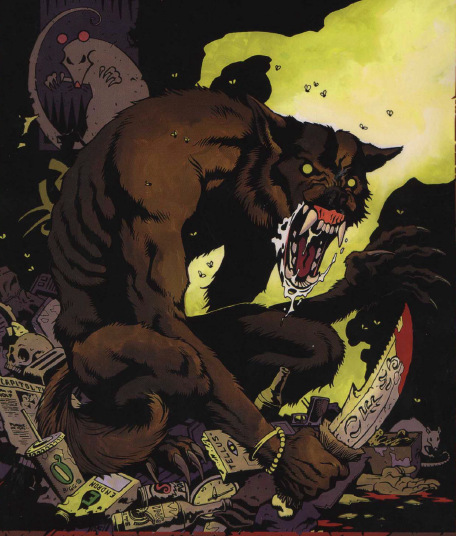
No joke, this exactly what a hobo werewolf would look like. Impressive.
Like last time, we’re going to look at the Revised Core entry for the Bone Gnawers and see what the writers are building on. Also like last time, the Bone Gnawers an atypical tribe in that their membership is more politically oriented than their place of birth. The Bone Gnawers are the poor werewolf tribe. This is probably a necessary archetype for Werewolf, since who doesn’t want to play a wisecracking, streetwise werewolf? Like Billy Joel from Oliver & Company, but angrier. The book even tells you that every Bone Gnawer is cynical, world weary, but totally hilarious! Archetypal as that is, it’s still evocative.
As briefly discussed in the Black Fury book, to be initiated into a tribe you have to be approved of by the totem spirit of that tribe. For the Black Furies, you had to impress Pegasus, and Pegasus automatically refused any non-metis males. The totem spirit watches out for its tribe kin, and if they change they’re more readily allowed into the tribe. They still have to do the Rite of Passage, but it’s less onerous. A werewolf can renounce his or her tribe and join another, but they have to work harder to impress the other tribe’s totem. For that reason, the Bone Gnawers are disdained, as the werewolves believe that they’re incapable of joining a “real” tribe.
That suits the Gnawers just fine, as they’re the most populous of the tribe. Anybody the other tribes don’t accept, they will. They’re originally from North Africa and India, but nowadays they can be found in any urban jungle. They’ve always lived among the poor and disenfranchised, and they claim to have teamed up with or been folk heroes. Their devotion to the common man leads them to espouse democratic values in their septs.
The Bone Gnawers also have weird totems and rites. They work with City Fathers, trash spirits, and other incarnations of the contemporary world. Their rites incorporate a milieu of pop cultural references. For instance, they’ll spread peanut butter to invoke the spirit of Elvis, or chant Frank Sinatra tunes to summon the spirit of New York. This only tarnishes their reputation even further, but the Gnawers will accept any ritual technique one of their members comes up with.
Living in the city, the Gnawers develop a few cultural quirks. Generosity is a big deal among the Bone Gnawers. Their elders, known as Fathers or Mothers, take in large swaths of unprivileged people to care for them, even if they’re not Kin or Garou. The Gnawer combat style is built around guerilla warfare and sneak attacks. They’ll work with anybody, even unsavory supernatural types. A developed system and lexicon for scavenging trash is popular among the Gnawers, delineating Stuff, Loot, and Things. (I’m not sure why this is included in the core, but it’s a fun idea from the Tribebook)
They have many camps, including some that live in rural areas. The Hillfolk are werewolf hillbillies and the Maneaters are werewolf cannibal hillbillies. In my estimation, the only thing better than a streetwise werewolf is a redneck werewolf.
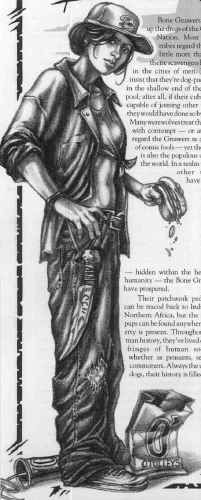
Not sold on this lady, though.
Appearance: They look pretty scruffy and mangy. Their wolf forms are covered in patches of different colors. They’re scrawny, but they can’t be mistaken for stray dogs.
Kinfolk: Unlike most tribes, their kin isn’t from a particular race or background, but they do tend to be poor.
Territory: The Bone Gnawers make their homes in the city, but in the poorest areas. This isn’t to say that they’re solely from the ghetto. They protect major public services in the city, including libraries, museums, parks and playgrounds.
quote:
Hey, you! Stop pissin’ on my damn box! What do you think this is, a men’s room? This here’s my home, and if you don’t zip it and run right now. I’m gonna have to bite that thing off. You hear me? I BITE!
The Bone Gnawers can’t have Ancestors, Resources, or Pure Breed backgrounds, but they get an extra willpower in return.
The Stereotypes are related to us by Piss-in-the-Wind. Bone Gnawers have great deed names, by the way. They like the Black Furies because feminism. They drink with the Fianna. They’re bullied by the Get of Fenris. They don’t trust the Red Talons because they want to kill everyone. They’ll feed the Shadow Lords info. The most interesting relationship they have is with the Silent Striders. Interpersonally they’re fine, but Owl has it out for Rat, so their tribes are constantly at odds.
Next time: The Long Dark Fast Food Breakfast of the Soul
Falling Down
Original SA post Tribebook: Bone Gnawers"Falling Down" and Chapter 1 Part 1
quote:
Once upon a time, I thought I was free.
You know that old axiom, “the first sentence of a story tells you everything you need to know”? Brian Campbell really seems to have taken that to heart.
The main character of “Falling Down” was a working stiff with three minimum wage jobs. He lived a pretty squalid lifestyle, making ramen in the coffee maker, drinking soda for breakfast, the worst. The job we're talking about today is Burger Czar at O’Tolley’s, the Pentex version of McDonald’s. He had a dorky uniform and his attempts to modify it were spoiled by his knowledge that thousands of other workers modified the uniform in exactly the same way. His main task was to take abuse from customers who buy food he can barely afford with an employee discount.
There were a few things that broke up his pathetic life. At O’Tolley’s, there was a regular customer who went by Walter, but everyone called him Wimpy. Wimpy was a crazy homeless person. He’d beg for change until he had enough to buy a single burger and a glass of water. He’d rant and rave about the kinds of things crazy homeless people rave about : conspiracy theories, giant rats, secret vampire societies. He was a weirdo and our hero hated him for that.
The second thing that brought our hero some solace was drinking with his friends. These particular friends were Black Dog fans who did all kinds of perverted shit in their games. If you got them started on their games they wouldn’t shut the fuck up, so instead our hero talked about his work, mostly about the crazy shit Wimpy would say. They had beer money, though, so they were okay.
One night, the crew was wandering around drunk and they came across Wimpy. Our hero saw Wimpy and thought about all the times he had to serve him and act polite to him and listen to his stupid stories. One thing led to another and the gang beat Wimpy down. Wimpy took it, as if he accepted that he was the kind of person these things happened to.
The next day, our hero woke up guilty. He kept to his routine (the only way to keep sane) and went to O’Tolley’s. Wimpy showed up without any marks or scars from the fight. The only thing different about him is that he bought his burger and left, no stories, no nothing.
A few weeks later, our hero was doing his routine, telling all the customers “Thank you very much,” no matter how much shit they gave him or how detestable they were. One customer, though, reacts strangely. It turns out that he had said “Fuck you very much, ma’am.” This of course gets him fired, and he’s ready to do a dramatic exit when he sees Wimpy laughing at him. This freaks him out, so he slinks out.
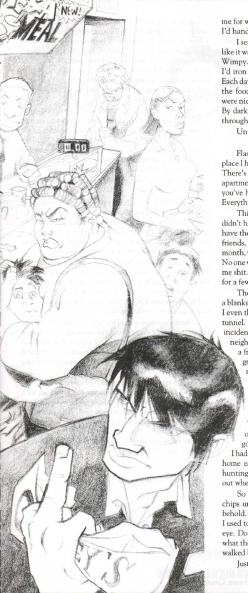
Bone Gnawers are too poor for ink.
For a month he hunted for a job, unwilling to debase himself before his stepfather. He was eventually evicted. Without any gas money, he decided to pack all his stuff in his truck and sleep in his car. He’d use his gamer friends’ house to bathe. One night, returning to his car when he got tired of his friends playing Revenants or whatever, he encounters Wimpy. This time, though, Wimpy shoves him. Wimpy kicked him around a little bit, and starts to grow and get a little fierce looking. Wimpy attacked him like an animal. Eventually Wimpy calms down and tells our hero that he’s a Bone Gnawer kinfolk.
Nowadays our hero is free. He’s not tied down by possessions or that shit. He lives out of his car. Every day he goes to O’Tolley’s and orders a single to take to Wimpy, and every day Wimpy says, “Thank you very much. Fuck you very much.”
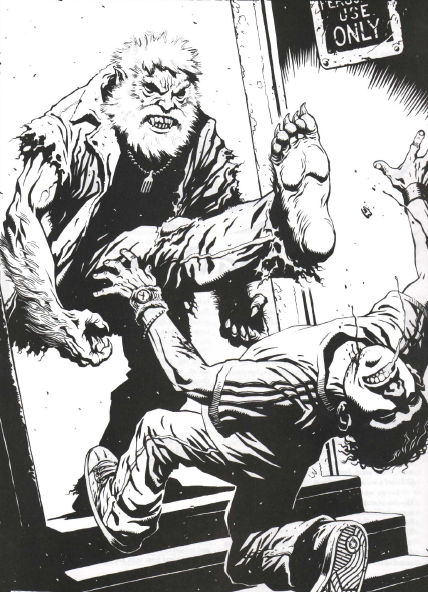
If you want a picture of the future, imagine a werewolf booting a human face, forever.
What a story! It’s pretty dang good. The problem is that it literally tells you that our hero’s life pre-Werewolf is crappy. The “homeless people have it great!” moral is also a little disconcerting. It’s one thing to believe that homeless people deserve their misery, but to actually believe that they’re better off homeless is, to my mind, even worse. Still, the description of low wage America is furiously awesome. It shows what the werewolves are fighting against superbly. It also gives us a good look into the kind of life a less homeless werewolf might lead. It goes for something very different than most tribebook intro fiction, and I like it.
[s]Next time: "An Elder Gets Drunk on History"[s]
Ah, fuck it. Let's start Chapter 1!
Before that, though, let's take a look at the credits page. Brian Campbell's the guy responsible for this book. It's hard to find a complete bibliography for him, but I happen to know he was the main writer for Clanbook: Nosferatu, so those of you mentioning the parallels between the two splats, you were on the money. Wikipedia tells me he worked on Star Wars and Call of Cthulu d20 properties. He also worked on Fading Suns, so he's made a lot of appearances here on F&F.
We have a light art staff for this book, and if there's one huge weakness to this tribebook, it's the art. The first picture in this update is pretty typical work. Ron Spencer is back on sample character duty. He has some great designs, but that's for another day. The interchapter art is also decent, if a little samey.
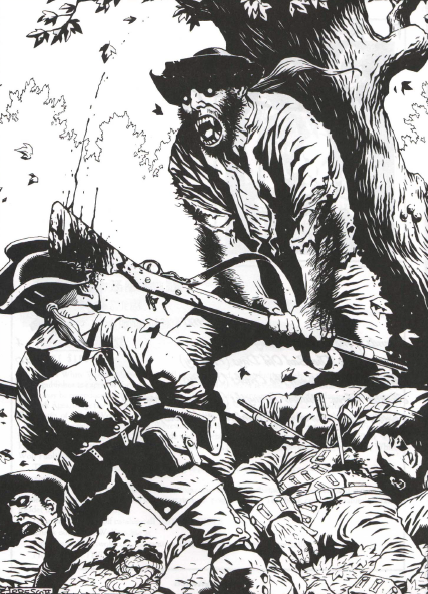
The Bone Gnawers have a long and storied history of hitting dudes in the face.
That aside, let's get drunk on history with an elder. The history chapter in Bone Gnawers is back to traditional White Wolf splatbook style, with various narrators offering perspectives. The chapter itself is a Recitation, a Gnawer storytelling ritual. One Galliard begins the story and anyone can interject if they believe they can tell the story better or if the leader draws a blank. Control of the story passes from teller to teller. Anyone can join in if they have the charisma and the moxy. This is actually a very traditional mode of tale telling, so it's great to see it here. The Gnawers also engage in Testimony, which is like Recitation, but it's in response to a request for information about a particular supernatural creature. If there's a vampire in town, various tellers will testify everything they know about vampires, for example.
The tribe here is gathered around a barrel fire, and a bottle of hooch is passed around to denote the storyteller. The elder begins his story by admitting that there's really no way for the Bone Gnawers to present a true account of their history. Unlike the other tribes, they can't contact their ancestors. Their lineage is too mixed for that. Of course, it doesn't matter much now that the Apocalypse is on its way.
The narrator alleges that the Bone Gnawer doesn't have a true ancestral homeland. They're more of an international werewolf community; if Gaia thinks you're good enough to be a werewolf, you're good enough to be a Bone Gnawer. Once you first changed, you left behind your humanity. You don't need tribal hierarchies or possessions or histories. The Bone Gnawers are a family, and there's plenty of room around the barrel fire. Rat looks out for her own and there's macaroni and cardboard stew to go around.
The Bone Gnawers are proud scavengers, lurking on the edges of history. The Bone Gnawers were tasked with taking care of all scavengers, spirits and animals and humans alike. The Gnawers protected humanity when the other tribes ruled over them. Bone Gnawers was an insult, one of the oldest in the Garou tongue. They were great warriors, overwhelming their enemies with numbers when all else failed. They were and are the shock troops of the Garou Nation.
Eventually, mankind built cities to protect themselves against the werewolves. Once the tribes realized that continuing to war against them was futile, the Concordiat was formed and the Garou Nation pledged to set itself apart from humanity to let human civilization to develop. Two tribes refused to do this. The nascent Glass Walkers were well-respected so they could do what they wanted. The Bone Gnawers, on the other hand, got the raw end of the deal. They couldn't survive without humanity to scavenge off of. So they stayed in the cities, in defiance of the Litany. The Silver Fangs declared them "urrah", or tainted, and so the Bone Gnawers formed their tribal identity.
Next time: "Forsooth!"
Walkers
Original SA post Tribebook: Bone GnawersAs the Bone Gnawers grew accustomed to the city, they noticed the Weaver spirits getting stronger and stronger. Humanity grew more organized, more regimented. The Glass Walker enjoyed the resources progress and the Weaver provided, but the Bone Gnawers were more wary. While the Walkers sustain the institutions and spirits that protect humanity, the Bone Gnawers fight to free us from them. The Walkers love human society, the Gnawers exist outside it.
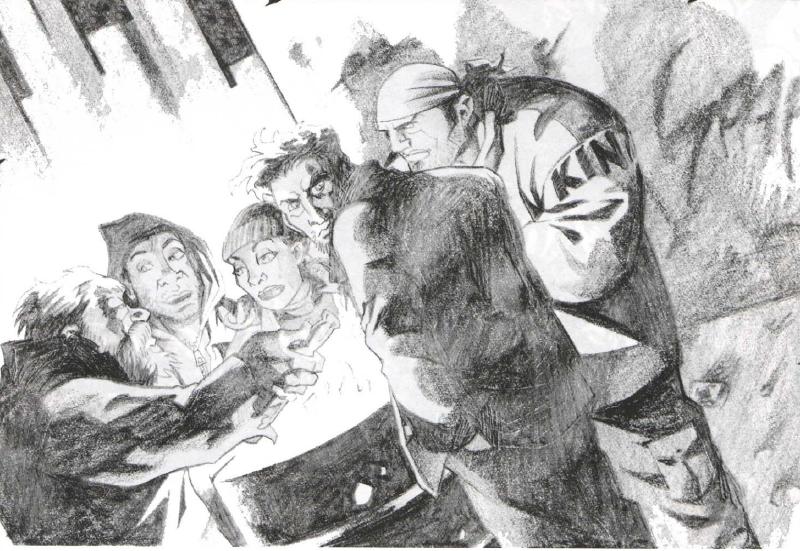
I'll grant that the interchapter art is alright, but everything else sucks.
The elder begins talking about the Gnawers of Ancient Egypt (made up of those rejected by the Silent Striders), but is interrupted by the alpha Teeth-of-the-Jackal, a metis. He denounces the idea that the Bone Gnawers have no pedigree, no history. The Gnawers are just more inclusive. They’ve widened their gene pool and are better for it. Considering how much problems the Silver Fangs have with inbreeding, this is probably accurate. The Bone Gnawers are spread out, but that’s not to say they don’t have a home.
Teeth argues that the Bone Gnawers are originally from North Africa, but the North African gnawers didn’t just follow Rat. Without wolf kin to call their own, the homid Gnawers followed scavenger spirits of all kinds, everything from jackals to hyenas to crows. The leaders adopted Jackal, the elders chose to follow Crow, the Ragabash and other politically oriented Garou took Hyena, and the rabble followed the universally popular Rat. Now that the scavenger spirits are returning, their stories can be told.
The Silent Striders are the canonical masters of North Africa. They were engaged in constant war with Set and his minions. The Striders were mostly losing, so they came to the Bone Gnawers for aid. Now, the Bone Gnawers were even then used to getting asked for help and then betrayed later. That made the followers of Rat not too inclined to strike the first blow against Set the blood god. The followers of Jackal, with more in common with the Striders and seeing an opportunity to earn some respect, did agree to help the Striders. Of course, both the Striders and the Jackal children lost. Set’s darkness wasn’t contained to Egypt, though. Eventually, it forced the Bone Gnawers out of their homeland. Today, the Bone Gnawers will never abandon another tribe in need, for fear that they’ll suffer the repercussions once again. It’s also why Owl demands rat sacrifices and hates the Bone Gnawers. Those Silent Striders who follow the Egyptian totems still are welcome among the Gnawers, however.
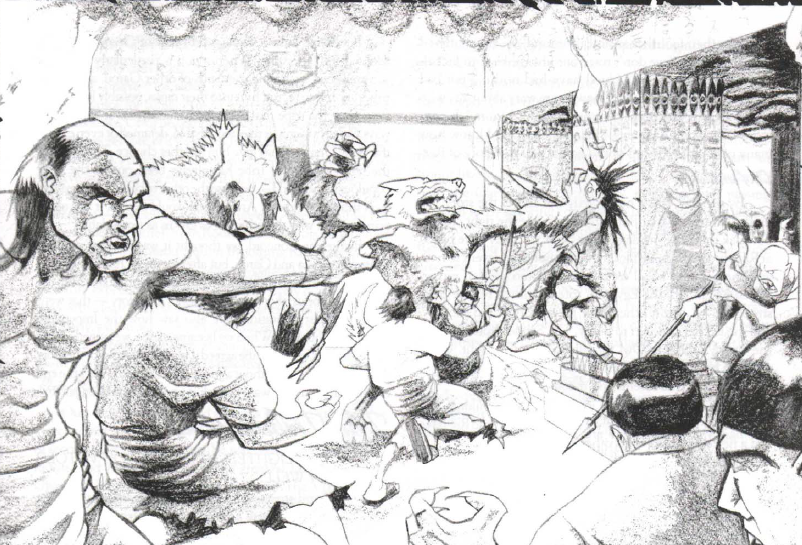
The Bone Gnawers always go for the face.
While the Bone Gnawers gained a lot of their population from less selective breeding, they gain even more from rejects from other tribes. Those cubs who can’t meet the expectations of their native tribe are accepted into the Bone Gnawers to prove themselves. In their native tribes, those cubs would be forced to eat last, to gnaw on the bones of the carcass. Hence, Bone Gnawers. The other tribes saw these rejects as expendable, and once the Gnawers believed that their sacrifice could earn respect. Now, though, they consider life too precious to give away on the expectation of other tribes. They’ll never sacrifice themselves today.
Smell-of-the-Crowd, a Frankweiler (a camp) picks up the story.
quote:
God’s wounds! What a tragedy this is, when Garou turns his back on Garou! Fear not, child! We shall shelter you from the night! We shall take you in as our own, clutching you to our very bosom!
 I think we have a contender for Best Camp. The Bone Gnawers form their own kin, a family of all those who Rat accepts. There are serious disadvantages to not having a tribe, some of them even mechanical. You can’t earn rites or tribe gifts. Joining the Bone Gnawers, even if it’s not cushy, is better than not having tribe at all. You can eat anything! You can live in cardboard castle! It’s fantastic. This may seem like glorifying poverty, but trust me on this, there’s something else at work.
I think we have a contender for Best Camp. The Bone Gnawers form their own kin, a family of all those who Rat accepts. There are serious disadvantages to not having a tribe, some of them even mechanical. You can’t earn rites or tribe gifts. Joining the Bone Gnawers, even if it’s not cushy, is better than not having tribe at all. You can eat anything! You can live in cardboard castle! It’s fantastic. This may seem like glorifying poverty, but trust me on this, there’s something else at work.
City life made it difficult for the Bone Gnawers to establish any organization. Without caerns to build a sept around, it was up to the oldest Gnawer in a given city to take care of all the other Gnawers. The way this worked was as diverse as the early cities. In some cities, every auspice had their own mother or father, a King of Fools or the Witch Mother. That practice is much rarer today, but it still survives. The Bone Gnawers have existed since cities have. In ancient Babylonian texts, there are records of Hammurabi dealing with rats; the Gnawers, of course.
And now, the most important sentence in the entire book:
quote:
We may look like fools, but we strive to be saviors.
The Glass Walkers are bound to the vice and greed and entrapment of the city, while the Gnawers simply do their work there. All the Walkers’ debts trap them even more. The Gnawers owe no one.
quote:
Friends and countrymen, attend! The Weaver is everywhere! (Stab! Parry! Thrust!) Every time you have to stand in line, with every form you’re dumb enough to fill out, with every bill you’re stupid enough to pay, she spins her web of deceit to bind you. Soon you’ll be anguishing how to pay our car bills, your espresso maker, your Franklin Mint miniatures. Soon, you’ll be blind to the world around you!
The Weaver’s all about conformity, but the Bone Gnawers break out of it, especially by devoting themselves to democratic ideals. The other tribes, rigidly hierarchical as they are, reject the concepts of democracy and equality, but the Bone Gnawers embrace everything the Garou Nation casts aside. With democracy, the Bone Gnawers could organize and help their human charges. They would even fight the Glass Walkers and the Shadow Lords to protect their kin.
All those ideals really came to a head in Rome. The Gnawers fought against the Glass Walkers among the patricians to protect the poor and maintain the ideals of the republic. They wandered the catacombs, feeding on the refuse of the Romans and pursuing their own goals. Eventually, though, they spread away from Rome, to the north. There, they assisted the Get of Fenris among the Vikings, serving as spear carriers. The Bone Gnawers always serve.
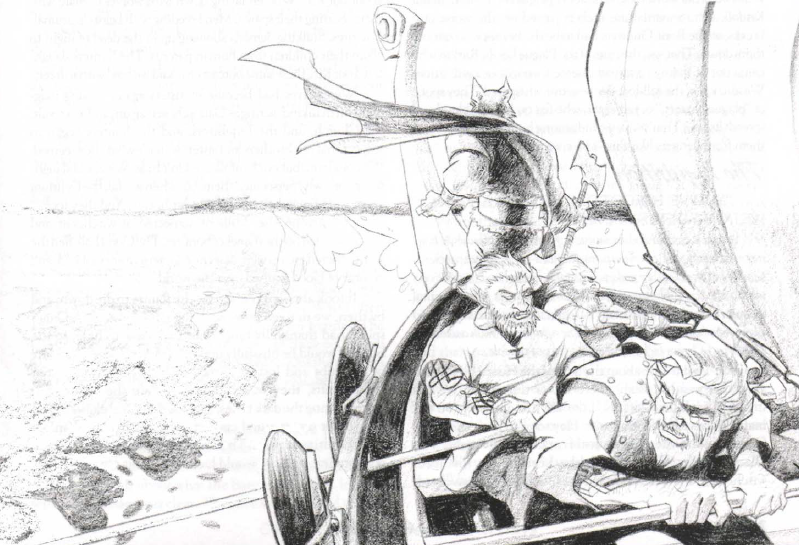
At sea or in an ice flow? You decide!
With that, the Smell-of-the-Crowd gives the stage to The Hood, a werewolf wearing a hoodie. He’s a member of the Hood camp. He gives a significantly more cynical view of Bone Gnawer history. Because of the Bone Gnawer’s commitment to serving the Garou Nation at large, they are the true source of power. Any Silver Fang or Shadow Lord ruler owes the Bone Gnawers a great debt, yet the Bone Gnawers persist at the bottom of the food chain.
quote:
Look at this poor sap. Living off garbage. Sleeping in the street in that smelly cloak. What’s so great about being homeless? Dropping out of life? Freezing at night? Starving by day? We’ve seen it up close. People around us dying a little each day. Day by day, they freeze to death. They starve to death. And if that’s not enough, they rip each other off along the way. For what? Money? Power? Privilege? For nothing.
We’re supposed to protect the world, and protect the people in it – even if the other tribal elders say we shouldn’t. The folks in our tribe slum just about everywhere. Because of it, the Garou howl that we’re rejects and losers. Don’t believe it. They say we’re cowards, bastards, lazy, selfish, or worse. Don’t buy it. Don’t forget the reason we stayed in the cities in the first place: to watch over mankind.
 This right here is the ethos that makes this book. It speaks to the tragedy of the tribe. The intro fiction sells the misery of poverty, but this sells the misery of trying to fight it. The Garou Nation has failed to save humanity. The Bone Gnawers are doing the best out of any tribe, but they also fail. Not only that, but they’re rejects among their own kind. They can’t help anybody, not even themselves. They can only watch and try to put as cool a face on it as possible. They can be heroes, but they are going to lose in the end.
This right here is the ethos that makes this book. It speaks to the tragedy of the tribe. The intro fiction sells the misery of poverty, but this sells the misery of trying to fight it. The Garou Nation has failed to save humanity. The Bone Gnawers are doing the best out of any tribe, but they also fail. Not only that, but they’re rejects among their own kind. They can’t help anybody, not even themselves. They can only watch and try to put as cool a face on it as possible. They can be heroes, but they are going to lose in the end.
Throughout history, they’ve tried their best but have always lost. In the Dark Ages, Robins Hood among the Bone Gnawers would hide their identities with their hoods and do their best for the peasantry. Even today, a Bone Gnawer camp accepts that legacy and carries it on. Yet feudalism persisted. They fought against the plague and the Ratkin agents that perpetuated it. Yet millions died, and even today, those Ratkin still threaten humanity and the poor have to deal with plagues as bad or worse. The Bone Gnawers cling to heroism, because that image is the only thing they have claim to.
Murder-of-Crows, a Philodox, brings up the ultimate failure of the Hoods. They and the supernaturals who took a direct hand in human affairs spurred the Inquisition. Thousands of Gnawer kinfolk were hunted down by superstitious inquisitors. The Garou could hide, so the brunt of the Inquisition’s wrath fell on their defenseless allies. Eventually, the Gnawer leaders held a Piping, grand moots of all the Bone Gnawers. The greatest of these councils was held in Barcelona. There, the elders issued the Ban of Man. No Gnawer could help or hunt mankind unless the tribe was threatened. Vigilantes and heroes alike were forbidden (The Hood, of course, has left the scene by now). Of course, the tribe at large still continued to do so, but the official tribe policy was to maintain their own survival above all.
Next time:

edit: The upcoming Exalted kickstarter has me excited! Because my tribal catalogue isn't ambitious enough, I'm considering doing a travelogue of the 2e Exalted setting, culminating in...something special. It depends on how much info the kickstarter has, though.
The New World
Original SA post
And I'm back! A short update today, but there's a good reason for that. I've been updating my old posts, clarifying some stuff that may have been confusing and stuff that definitely confused me. With that out of the way, we can get to
Tribebook: Bone Gnawers
The Bone Gnawers really came into their own during the Age of Exploration. After the success of the first Piping, further tribal moots became commonplace as communication and travel improved. The amount of Garou that could reasonably claim the name “Bone Gnawer” increased. The Bone Gnawers began to have an actual political presence in the Garou Nation simply because they could actually agree on things and make their existence known. Many Gnawers gained upwards mobility, well, at least among the Bone Gnawer ranks.
The urge for exploration eventually led the Gnawers to the New World. Various Gnawers stowed away on the early voyages and sent back reports about the land of plenty. Eventually, a new Piping was called in Lisbon, and the Gnawers planned a mass exodus. They got assistance from other tribal elders, who wanted information and expendable scouts to get it. The Gnawers were promised respect, but of course, they didn’t end up getting it. Tired of their treatment among the other European Garou, they left, with Corazon Bitefinder leading the exodus. The Pure Tribes resented this, naturally, but the Bone Gnawers began the European Garou presence in the Americas.
The story is here picked up by Welcomed-into-the-Hall-of-Presidents. When the Gnawers found America, they finally became a full-fledged tribe. Their early sponsorship of the democratic revolution gave them a stake in the Garou Nation they never had before. They were the patrons of America, and the other Garou had to respect that. No other tribe, save the Pure, can claim to be as home in the USA as the Bone Gnawers, and even the Pure are uncomfortable in today’s United States.
Helping the American revolutionaries would mean breaking the Ban of Man. To do so, the American Gnawers developed the High Ban. The Gnawers could still fight in homid form, but not use any of their werewolf powers. They couldn’t sneak through the Umbra to attack supply lines or use cool rites or gifts. If they were grievously injured, they could still retreat to heal, but they were out of the war for good. This way, they could still help their charges while maintaining the Veil. The High Ban is still in common practice today.
The success of the American Revolution inspired other revolutions, most of which Bone Gnawers participated in. The revolution they’re most proud of is the French Revolution, created to distract the humans from the Gnawers’ true mission: to kill all the Parisian vampires. With the help of the French Ratkin, the Gnawers purged France of vampiric influence. During the Russian Revolution, the Sept of the Noble’s Will, a caern granted to the Bone Gnawers by the Silver Fangs but ruled by their nobles, was overthrown, becoming the Sept of the People’s Will. The Fangs retaliated harshly, but they’ll never rule the caern again.
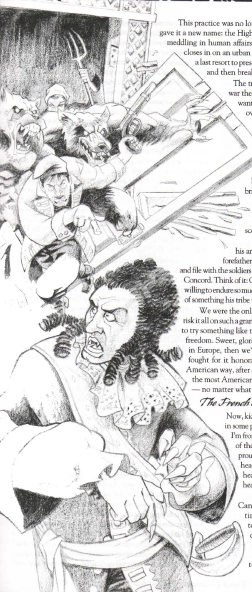
Perspective? What's that?
That aside, the new governments were entirely developed by humans, and the Bone Gnawers freely admit that (the vampires won’t, but that’s a story for another day). However, the Garou Nation failed to develop. The elders the Bone Gnawers made a home for took power from the Pure Tribes. In protest, many Gnawers left the tribe and explored the west as ronin. These Gnawers became the Hillfolk, taking up rural trades and filling the wide wild landscape of America.
The next section is titled “The Civil War”, but it’s not about that at all. Instead, it’s a discussion on totems. As more and more Bone Gnawers concentrated in America, the local scavenger spirits grew more powerful. In time, the access to these spirits made the United States the new Bone Gnawer homeland. But the scavenger spirits no longer fully encapsulated the Gnawer agenda. At long last, the Bone Gnawers began to hope. They believed in the promise of America, along with everyone else. And so, the American Dream took on sentience and became one of the patron Bone Gnawer totem spirits. It represented the ability to create new traditions if the old didn’t suit you, to find a new home if you were thrown out of your old. The America Dream is a full-fledged Incarna, and it’s among the most popular Bone Gnawer totems.
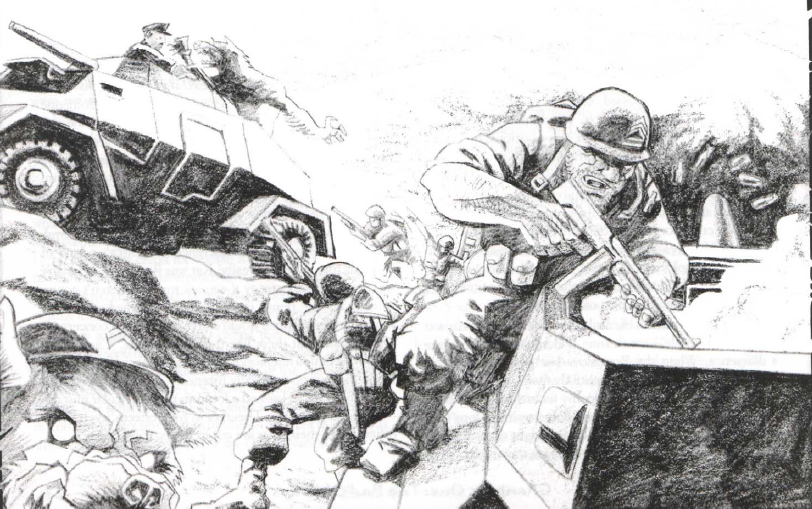
That werewolf is wearing a WWII army hat. I take back everything I've said about the art.
During the Gilded Age, the Glass Walkers’ wealth increased tremendously. The Bone Gnawers hitched their wagon to theirs, serving as the muscle to the Walkers’ brains. Together, the two tribes ruled the bootlegging industry. The tribes got along well, but it wasn’t like they were going to become one urban tribe. Then the Great Depression came around. The Walkers were hit hard, but they passed most of the hurting to the Gnawers. The Gnawers, then, were in a real tight spot. They became more involved in human affairs than ever, raising funds, defending tent cities. Their conduct proved that the Bone Gnawers could really make a difference where the other tribes couldn’t.
Hall closes the Recitation by describing World War II. The destruction caused by that war confirmed that the End Times were finally here. Teeth-of-the-Jackal urges his followers to start acting now, because the Apocalypse is here and there are no consequences. It’s the perfect time to finally change the world for the better. The Bone Gnawers can finally live to the fullest. Meanwhile, the Old Man who began the Recitation drifts off to sleep in an alley. A crow spirit takes his fetish dagger and flies away. The Old Man is dead.
Next time: Finally quoting Tyler Durden
Bone Gnawer Society
Original SA post Tribebook: Bone GnawersChapter 2, Part 1
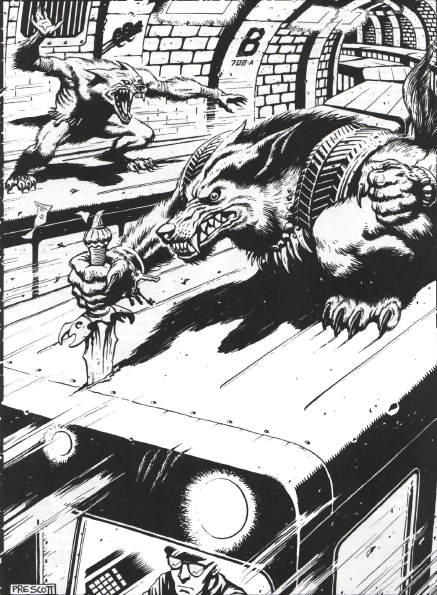
Scott Prescott, I know you can do better than this. See me after class.
In sum, the Bone Gnawers live on the fringes of society, avoiding the Weaver’s grasp, and are idealistically dedicated to equality and democracy for all. Of course, they’ve failed to actually promote these changes to the extent they would like. Other tribes may even consider their opposition to hierarchy as an easy excuse for laziness. Their life on the fringe doesn’t make them any easier to like: they smell, they look degenerate, and they often go insane. Theurges sometimes get lost in the barrier between the Umbra and our world, losing the ability to tell the difference between the two.
There are Gnawers who simply want to abandon the hierarchies of the Garou Nation and disperse. They still fight the Wyrm, though, making them the only line of defense in areas without many werewolves. All Gnawers are determined to survive and develop the talents necessary to do so. When all the other tribes fail, the Bone Gnawers may be the only ones with hope.
Before they change, Bone Gnawers still find themselves at the fringes of their society. The point of conformity and order becomes foreign to her. Wealth, success, all the rewards of conventional human life are worthless to the nascent Garou. The injustices of society make the cub angrier and angrier, until the RAGE boils over. After that, the discomfort of society only grows into a choking ozone miasma. But, they also have a way to at least more tangibly fight the corruption of the world.
Many Bone Gnawers aren’t born into the tribe, but their reaction to their First Change places them there. If a new werewolf shuns all society and gives in to the survival urge, he may be a good candidate for the Bone Gnawers. Some werewolves go insane at the First Change, becoming Lunatics, and the Bone Gnawers accept them too. Cubs lost by their kin-fetches (guardian spirits) may find themselves running into the arms of the Bone Gnawers. The Gnawers’ dispersal and large population often puts them into the position of the first Garou a new werewolf meets. Their reputation also sends them “problem cubs”, those new werewolves that the other tribes don’t know how to handle.
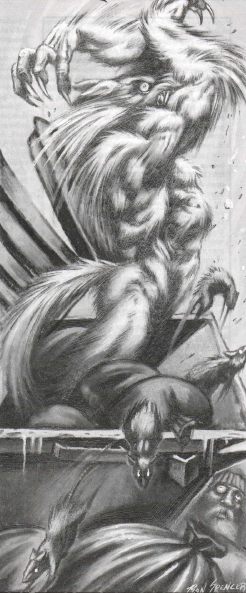
What happens when a werewolf gets an itch. Also, I love the guy in the lower right hand corner.
There are Bone Gnawer kinfolk, though. Throughout history, the Bone Gnawers have found themselves attracted to working class heroes. The worthy are inducted to their line. Social mobility being what it is, most Gnawer kinfolk are still proud members of the working class, or less proud members of the impoverished.
Why do the Bone Gnawers recruit so many cubs? Their Rites of Passage are a joke, and many members don’t even go to any tribal events. Many tribes accuse them of just fleshing out their numbers. There is some truth to this. The Bone Gnawers can call upon their rabble in times of need, and they will come. The rabble includes Garou with a variety of talents, most which involve violence and crime. It’s the Bone Gnawer secret weapon. It’s what makes the Bone Gnawers such effective shock troops and what makes them expendable.
Members of the rabble have it rough, especially those who are truly anti-social. Without a pack support structure, werewolves tend to fall into Harano, werewolf depression. To prevent this, rabble members often join impromptu packs to accomplish discrete tasks, like finding shelter or planning a convenience store robbery. They also use the Gift Tagalong temporarily assist other packs.
The stereotypical Bone Gnawer sept is based around an urban caern, but there just aren’t enough for those to be truly popular. Not any public park is going to be pure enough to open a caern. Even if you do have a caern, it’s difficult to open it or defend it in the middle of a city of millions of people. Nonetheless, they still exist, and there are some yet to be opened.
The Sept of the Green is one of the most famous and important Gnawer septs. Based in Central Park, it supports about 50 active members of the Gnawer. It’s led by Mother Larissa and it accepts any guest who asks for assistance, much to the consternation of the Get and Shadow Lords. The Sept of the Awakening in Washington DC supports itself on the spiritual energy of democracy and patriotism. It welcomes werewolves with a political bent, particularly the Black Furies and the Children of Gaia. They have a bit of a vampire problem, though. We’ve already talked about the Sept of the People’s Will. The Bone Gnawers there overthrew their Silver Fang sept leader and now run it communally.
Many Bone Gnawers fearful of the corruption of the city found septs in rural caerns. Often formed around families, the rural septs rely on communication between smaller cells across the country. They adopt the folk ways of their kin families and maintain connections between hundreds of septs.
Time for a scary story! Until a few years ago, the Sept of Dandelion Hill was a fairly anonymous caern overshadowed by other more famous Appalachian caerns. One Memorial Day weekend, a group of cliath from New York showed up at the Sept’s doorstep, looking for information on a fetish. They saw that the sept had a lot of fetishes of their own, predominately featuring carved bone. The guests were invited to a feast. The Ragabash of the tribe grew curious about her meal and investigated. She eventually found a shed, filled with desecrated human corpses. Over the next three days the pack was hunted down by the sept. One pack member managed to escape and alert nearby septs, who destroyed the Dandelion Hill Maneater cult. It turns out that the cult had killed over fifty humans and ate them. The echoes of those three days still persist in the Atrocity realm.
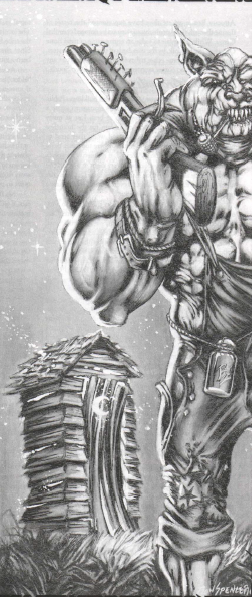
In case you can't tell, this werewolf has a corncob pipe. Ron Spencer is my favorite.
Most urban septs don’t have a caern to base itself around, so the tribe has invented its own method of finding space. While on the move, a group of Gnawers can find a place to stay the night. They consecrate it, forming a Stomping Ground. These Grounds will often be found in tent cities, underpasses, or anywhere else a gathering of homeless people wouldn’t be too suspicious. The spots are guarded carefully and urban spirits will let the werewolves know if anything is amiss. Humans are allowed inside these Grounds, and many valuable connections are made by offering this protection.
As egalitarian as they are, the Bone Gnawers still have elders that they respect. Anybody with the requisite renown can claim to be an elder, but they need to make that claim before a Bone Gnawer audience and have a majority accept their claim. Even if that audience isn’t exactly representative of the Gnawers at large, it still counts, although a successful elder will listen to voice of the people. Another good way to earn favor is to offer gifts. Generosity and compassion are among the top qualities the Bone Gnawers look for in elders, and generosity in the approval process indicates you’ll continue to act that way. Other tribes call this corruption, of course. Venerable elders are given the title Mother or Father, the only titles the Gnawers have.
Focusing on survival above all, Bone Gnawer war heroes are rare. There are those that do dedicate themselves to earning glory, though. These are known as the Rat’s Teeth, and your Bone Gnawer character is presumably one of them. Otherwise he’s fucking around getting food in the city. That can be fun, but that’s not really what Werewolf’s about. Because of the Gnawer dedication to equality, earning respect as a Gnawer can be a challenge. Even if you’ve saved the city, you still have to live like the rest of the Gnawers and are subject to the same obligations.
Both the Gnawers and urban spirits participate in a complex economic system known as “Stuff, Loot, Junk, and Shit.” Loot is really useful things that you find on the street. It can sell pretty well at a pawnshop. Junk is things that don’t really work or aren’t useful, but could come in handy one day. Spirits will do a lot for just the right piece of Junk. You don’t want to throw it out, but it’s not exactly Loot either. Stuff is in between Loot and Junk. It’s stuff that is yours. While not as useful as Loot, it’s part of your identity. Unlike Loot or Junk, you’ve claimed ownership of Stuff. You’re not going to part with it in a trade because it is yours. A gift of Stuff is a honored gift indeed, at least to a Bone Gnawer. Shit is shit.
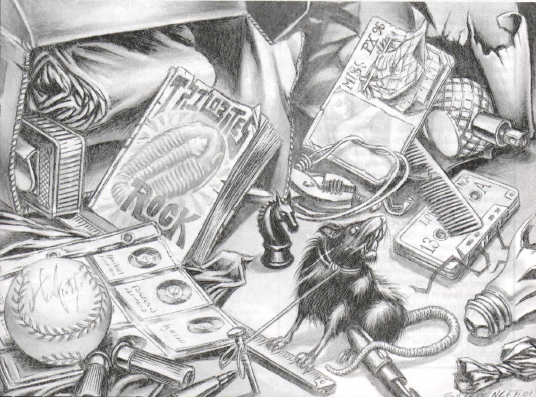
I'm pretty sure "Trilobites Rock" is an in-joke, but I can't place it. Can anybody else give a hand?
Loot, Stuff and Junk have spiritual uses. In the Umbra, dilapidated items become better, more platonic forms of what they are. A broken umbrella may become a shield against acid rain spirits, or a ratty overcoat may become a badass trenchcoat. Loot forms are better than Junk forms, for the most part. Stuff has the best forms for its owner, so Gnawers will hold on to their Stuff. Theurges find Stuff the most useful, since they can personalize their Rites with them. A material component for a Rite can be exchanged for something that fulfills the same metaphysical purpose. The Rite of the Questing Stone, for instance, can be performed with a compass and wire, rather than a rock and string.
Next time: Sleeps-with-the-Fishes and friends
Auspices
Original SA post
Apologies to Syrg for not providing titles for my updates! I'll do so from now on.
Tribebook: Bone Gnawers
Chapter 2, Part 2
Quickly, now, the auspices!
Ragabash
are clowns and criminals. Their humor hides their devious dealings!
Theurges
are either crazy seeming urban shamans or compassionate healers giving their services to the needy. Bone Gnawer
Philodox
are more engaged in human politics and welfare than their tribal counterparts. They make the democracy of the Gnawers possible with their mediation.
Galliards
are slam poets and street performers connecting the Bone Gnawers to their human charges.
Ahroun
specialize in underhanded tactics. They swarm their enemies with sneak attacks, wearing down the enemy to save their strength for survival. More aggressive Ahroun Gnawers specialize in terrorism.
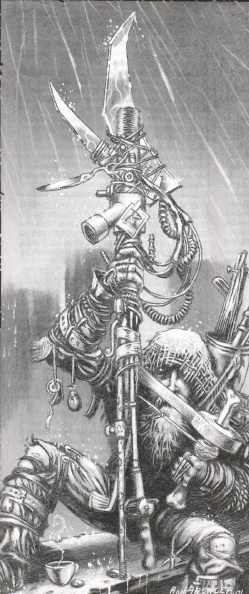
If Rob Liefeld could draw, this would be his interpretation of a spear.
Homid
werewolves still shun human society, but are the most adept at existing at its fringes. They keep to their human forms, all the better to not arouse suspicion. However, werewolves can’t regenerate in their breed forms, so Homids are especially eager to join Umbral adventures or pack raids in order to slough off some of the ravages of living on the street. Contrary to popular opinion,
Metis
aren’t really treated any better in the Gnawers than in other tribes. As outcasts, there just tend to be more Metis in the Gnawers than in any other tribe, and they’re treated as such.
Lupus
are never born from dogs. Some Gnawers have experimented with it, but it’s an embarrassment and never works. Many Lupus are bred in captivity, but they are still full wolves, with all their instincts. Some wolf kin travel into the city to live, scavenging and sneaking. A recent flood of urban Lupus is causing some Gnawer leaders concern.
The Bone Gnawers can’t take the Pure Breed background at chargen, so to speak. Because of all the people they’ve integrated into their breeding stock, there’s no such thing as a Platonic Bone Gnawer. Because of this, there isn’t a purebred upper class among the Bone Gnawers that can get respect with other tribes, yet another thing demoting the Gnawers to second class status in the Garou Nation. Gnawer kin can be found in among ethnicity. This means that a Bone Gnawer might find himself kin to another tribe. For instance, a nineteenth century Gnawer might later join the Fianna, meaning that many present day Fianna can find a Gnawer on their family tree and vice versa. The Gnawers tend to leave behind illegitimate children. Some rationalize this, claiming that a true Bone Gnawer can survive such adversity. There’s pushback against this attitude, of course.
Most Bone Gnawers devote some of their time and energy to promoting certain causes. Communities of likeminded Gnawers form camps. Some have formal structure while others just share common ideals. Many camps actively recruit Gnawers to help in their projects and cause, while others are secret societies, usually involved in crime.
Rat Finks:
quote:
Sleeps-with-the-Fishes, a Ragabash informant, can give you a tip or two:
“You want facts? We’re going to play a little game. You ask me a question you want answered. I’ll tell you what I want to know in exchange. If you want the truth, it’s going to cost you. Now, write down what you want…take it to the fourth bathroom stall in the O’Tolley’s restroom…stick your question to a piece of chewing gum…and leave it inside the toilet paper roll. One of our rat-spirits will contact you.”
The Rat Finks are information traders. Gnawers tend to have contacts with many menial laborers: janitors, temps, clerks, waiters, etc. The Rat Finks can get a lot of information from these contacts, and they put it to work. They may help plan corporate raids on the basis of some particularly sensitive piece information. More often, they’ll play it more subtly, spying on a target company to see what it’s up to.
As implied the representative quote, the Finks’ trademark is unusual transmission methods. They have a complex system of codes and buzzwords and even more ways to get a message to someone who needs it. They might send codes via personal ads, a child’s clothing, street signs, or even Goldbergian instances of random happenstance.
The Rat Fink connection network isn’t limited to Kin. The Ratkin and Corax can be taught Fink codes to be inducted into the loop. In return, they can learn some especially juicy secrets. Even some Nosferatu are allowed in the circle. The Finks are less likely to trust other tribes, especially the Glass Walkers. No Walker is ever allowed to learn the Finks’ secrets.
Most Gnawers participate in the Finks without actually becoming a member. They’ll be called upon to do some cryptic task or to gather some information, usually by an unexpected source. In return, they may find themselves with better political success. Certainly they’ll have access to some very privileged information, or at least very privileged sources. Few Gnawers are actually full members of the Rat Finks.
Frankweilers: Frankweilers are the guardians of museums, public libraries, anywhere that has free or cheap admission and is devoted to education or culture.They’re named after From the Mixed-Up Files of Basil E. Frankweiler , a book where two children live on their own in a museum after hours. The Frankweilers tend to live and stay within a one or two block radius of their preferred cultural hotspot to protect it.
The Frankweilers were originally known as the Theatre Lupine and although they focus less on the high arts today, they still avidly participate in showing classical theatre to the caerns, giving a very unique flavor to their traditional Garou stories. Some Frankweilers take on their theatre personas everywhere they go, becoming quixotic classical heroes. They even take on the names of famous literary characters.
The camp is known for being great educators and public advocates. They teach literacy or ESL, participate in health awareness programs, or even act as pro bono lawyers. They tend to be college dropouts or unlucky humanities majors. Where the Wyrm tries to prey on malaise and despair, the Frankweilers fight it.
The Hood:
quote:
For a protection racket, the Hood ain’t half bad.
The Gnawers are known to have a secret network of untraceable criminals. In every city, a Bone Gnawer elder can call upon some identitiless shmuck with no name to do whatever dirty deeds need doing. The Hood are one particular wing of this anonymous culture. They pledge to rob the rich to give to the poor, like their namesake. In name, the Hood acts separate from the rest of the tribe, but elders will still award them renown for their illicit activities.
The Hood does three things: hunt down and mark the filthy rich, with an emphasis on filthy. Wyrm taint often goes along with wealth. There are plenty of exploitative assholes who aren’t involved with the Wyrm, though. Even the Glass Walkers are sometimes targeted by the Hood. Then, they give their earnings to charity. It only goes so far, though, as their money comes with strings attached. Behave poorly and you earn the Hood’s wrath. The last activity of the Hood is to protect the homeless by any means necessary, but they only save the homeless worth saving. When the Hood helps someone out, they’ll stick around to make sure he stays safe, both from enemies and from himself.
Deserters: As the Apocalypse draws near, many Gnawers are trying to find ways to escape Earth before it all blows up. These Gnawers are experts and navigating the Umbra, spending more time there than many spirits. They plan and execute voyages farther into the Umbra than any other werewolves. They look for a way out .
It seems, though, that there is no way out, and many wayward Deserters are coming home. All their time in the Umbra has left them detached from the world, and now they’re even more homeless than the rest of the Gnawers. They’ve seen the things man was not meant to know, and they refuse to talk about it. Many have gone insane. They can’t recognize the artifacts of material life anymore. They do retain their extensive knowledge of the Umbra, though, and can be vital resources for any Umbral adventure. They may join other packs, but they’re liable to jump out into the Umbra for exploration.
Road Warders: The name says it all. These Gnawers explore the roads, seeking out Wyrm creatures to slay. They sneak aboard buses and trains, and they’re masters of hitchhiking. Unlike the Silent Striders, the Warders don’t really have a destination in mind when they travel. The journey is their only purpose. It makes them unreliable messengers or diplomats, and they refuse the jobs anyway. Their adventures on the road expose them to a variety of connections and friendships that can be valuable on their next excursion. They have a tendency to show up at Bone Gnawer septs just when they’re needed, bringing news of Wyrm threats or other pressing matters. Werewolf hitchhikers is what I’m getting at, here.
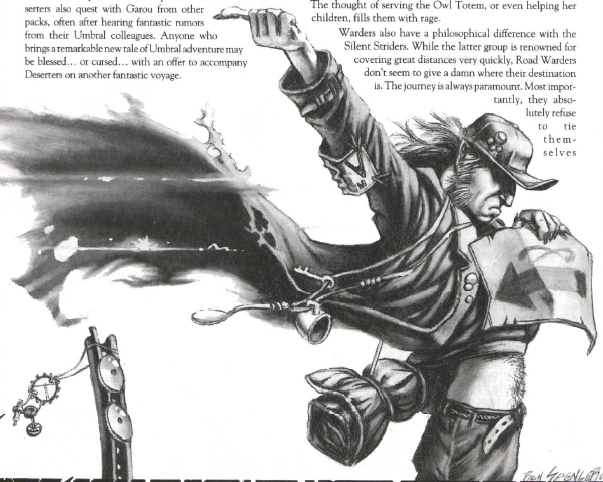
This guy looks trustworthy enough to let into your car.
Hillfolk: Hillbilly werewolves! These guys live down south and in Appalachia. They reject all modern technology, instead perpetuating the folk traditions of their chosen people. All the standard hillbilly stereotypes are applied to the Hillfolk. They’re seen as inbred and backwards. They do indeed drink moonshine, but the Hillfolk prefer “true moonshine”, infused with Wyld energies and too potent even for the Fianna. They scare off any “revenuers” (tax collecters), leading to stories of cannibal rednecks. Living close to fae strongholds, they develop lots of changeling connections.
The Swarm: While Rat is a totem of war, the Gnawers prefer sneakier tactics, to the disdain of the other tribes. They prefer guerilla tactics and sneak attacks to the Silver Fang duels. If the Wyrm isn’t going to fight fair, the Gnawers reason, why should the Garou? They aim to survive to continue the fight rather than seek glory or honor.
The Swarm are the masters of this fighting style. Worshippers of the Rat God, Rat’s true war aspect, they lie in wait secretly, waiting for the opportunity to fight for the tribe’s survival. When Gnawer elders encounter a situation that can’t be resolved with diplomacy or subterfuge, they call upon Rat’s Teeth, and when they do they strike hard.
Members of the Swarm often receive a personal vision from the Rat God, filling them with unquenchable bloodlust. They can act as sleeper agents in other packs, even devoting themselves to other pack totems, while still committing acts of urban terrorism and attacking vital targets.
That was the camps! Gotta say, these camps are great. There’s not a really boring pack among them. While the Sisterhood in the Black Furies can be made exciting with a little bit of work, every camp here provides flavorful character hooks. The Hillfolk are the weak point here, since while werewolf hillbillies are cool, it’s not exactly fertile ground for characterization. Still it’s better than the Amazons of Diana, whose hook was literally “We fight the Wyrm,” in a game where the Wyrm is the primary antagonist.
Next time: "You would speak of culinary habits..."
Laws/Stereotypes
Original SA post
It's been a while, but here's more
Tribebook: Bone Gnawers
Chapter Two, Part 3
The only thing that sets the Garou apart from common monsters is the Litany, and so every Garou follows it. It’s the very basis of any form of werewolf community, at least in the Western Concordiat. The problem is that the Litany isn’t a written legal code. For those of you versed in legal parlance, it’s a system of common law rather than constitutional. Thus, any ruling or understanding of the Litany is based solely on precedent. This is brought to extremes by the Concordiat’s modern oral society. The letter of the law may as well not even exist compared to its spirit.
Because of the dominance of precedent in werewolf law, any ruling is by default rigged against the Bone Gnawers, as time and time again they’ve been ruled against in the past. The Litany is built to support heroes, and the Bone Gnawers are manifestly not heroic. Even when they’ve won cases, it’s the Philodox of the other tribes that are recognized for defending them. To avoid this, Bone Gnawers usually seek justice among their own tribe, since they’re more likely to have favorable precedent than other tribes.
Cut to a transcript! It’s a formal debate on whether to find all the rabble in New York accountable for violations of the Litany. This could mean that they be banned from any moots. Pro-exile is Zachary Ellison, a Shadow Lord. The contra side is taken up by Victor Bonecrusher, a Gnawer Metis. Most of the other tribebooks put very little effort into their Litany sections, so this is welcome, but at the same time it’s long and if you’re not interested in werewolf court drama, you probably won’t find this interesting. Then again, Law and Order with werewolves sounds pretty great.
First up is
Garou Shall not Mate with Garou
. Ellison alleges that the Gnawers have been fucking non-stop, boosting their ranks with lazy Metis. Most other tribes put their Metis to work, forcing them to guard their septs and perform other arduous tasks which the Metis are suited to as giant wolfmen, but the Gnawers don’t do that. Bonecrusher argues that they treat the Metis like any other Gnawer because the Metis haven’t done anything wrong. The truth is that the Bone Gnawers are a little lax on restricting sex; it’s only a crime if you’re caught. Most Gnawers know or learn how to use protection. Still, it’s werewolf incest, and that’s just gross. Metis are outcasts, and therefore accepted by the Gnawers, but they will still exile any Garou that produces one.
Next is
Combat the Wyrm Wherever it Dwells and Wherever it Breeds
. Ellison is upset that the Gnawers tend to align themselves with Wyrm tainted parties, like the Ratkin or vampires. Bonecrusher points out that the Shadow Lords do the same thing. The only difference is that the Bone Gnawers’ deals don’t tend to blow up in their face. The Bone Gnawers are focused on survival, so the committing to destroying all the agents of the Wyrm everywhere is impractical. They tend to fight more indirectly, focusing on helping communities affected by Wyrm taint.
Respect the Territory of Another
is a difficult tenet to uphold in the city. Ellison accuses the rabble of sneaking into different septs without introducing themselves and helping themselves to valuable resources. All Bonecrusher can say to this is that introducing ones’ self in Garou culture often means a recitation of lineage, which many Gnawers can’t do. Instead, the Gnawers uphold the sanctity of foreign territory in their own way, not pissing anybody off, messing up the local ecosystem (such as it is), or performing illicit business in another party’s turf.
Ellison says that the Bone Gnawers can’t
Accept an Honorable Surrender
because nobody would surrender to a Gnawer!
 Bonecrusher offers to punch Ellison’s lights out. Bone Gnawers tend to abuse this law in physical challenges, but they’re very adept in non-traditional duels. The Gnawers have mad basketball skills. On the streets, though, members of the rabble will fuck each other up and expect to be fucked up in return.
Bonecrusher offers to punch Ellison’s lights out. Bone Gnawers tend to abuse this law in physical challenges, but they’re very adept in non-traditional duels. The Gnawers have mad basketball skills. On the streets, though, members of the rabble will fuck each other up and expect to be fucked up in return.
The Gnawers just tend to go through the motions of
Submission to those of Higher Station
, and both Ellison and Bonecrusher know it. Bonecrusher, though, argues that their impoverished state is submission enough. The Gnawers really do respect their own Mothers and Fathers, but anybody else can just expect a Rite of Contrition once in a while.
On to
The First Share of the Kill to the Greatest in Station
. Ellison says that all the Gnawers have to offer is cardboard stew, but Bonecrusher points out that showing disgust at a gift of food from a starving man is a dick move. The name “Bone Gnawers” is derived from their position of getting access to a carcass last. Thus, the Gnawers pride themselves on their propensity for scavenging. Often, an elder Gnawer will claim the greatest share of the loot on a scavenging mission. Otherwise, it’s every werewolf for himself.
Speaking of food, Ellison accuses the Gnawers of producing cannibals in violation of
Ye Shall not Eat the Flesh of Humans
. Bonecrusher argues that the Gnawers devote themselves to hunting down the remnants of the Man Eaters of Dandelion Hill. They have specialized rites for it and they’re all trained to find the telltale signs. Whether or not there are still Man Eaters in the tribe is unclear (plot hook!), but the Gnawers focus on it anyway.
Ellison then argues that the Bone Gnawers have failed to
Respect those Beneath Ye – All are of Gaia
for failing to properly care for their cubs. They’re forced to scavenge and scrounge. They’re improperly dressed, educated and fed, and the Gnawers have full responsibility for that. Bonecrusher retorts that the Shadow Lords, as superior to the Bone Gnawers, could also care for the cubs, or even the Gnawers as a whole. The Gnawers’ focus on democracy is traditionally justified with this code, as it makes the elders directly accountable for respecting their constituents.
Because the rabble aren’t accountable to anyone, there’s a danger that they’ll endanger
The Veil
. Ellison can’t verify whether there have been any breaches, and that worries him. Bonecrusher takes this as a sign that the rabble are capable indeed. The septs themselves don’t allow anyone out of Homid form, but this renders their caerns vulnerable to attack.
Do Not Suffer Thy People to Tend to Thy Illness
is violated by the Gnawers respect and veneration for their weak elders and their mentally ill street prophets, Ellison argues. Bonecrusher argues that they need their wise leaders, so they’re not really tending to anybody’s illness. Sometimes, elders leave the protection of their septs to brave the streets, proving their capacity to survive as a Bone Gnawer. Street prophets need to prove their ability before earning the respect of the tribe, as well as their ability to take care of themselves.
While the Gnawers aren’t likely to
Challenge a Leader During Wartime
, they will refuse to rally to a war leader’s cause, preserving their own safety. Challenging a Bone Gnawer leader is a moot point, since democracy means that anybody can be a leader. Bonecrusher responds that tons of anonymous Gnawers have died for the Garou Nation’s wars and they must be respected for that. Truly, the Gnawers devote themselves to their leaders, as their strategies rely on pack tactics.
Ye Shall Take No Action that Allows a Caern to be Violated
is a tenet that the Bone Gnawers take very seriously. There are very few urban caerns, and for the most part the Gnawers are responsible for protecting them. Thus, anyone who lets one of these caerns go is verboten among the Gnawers.
The final verdict is a compromise. The rabble are allowed to moots, but they’re subject to more scrutiny. Bonecrusher believes that he won, but it’s likely that Ellison threw the debate to continue investigating the supposed depredations of the rabble.
Time for stereotypes!
Black Furies
: Sleeps-with-the-Fishes thinks that they’re just as committed to social justice as the Bone Gnawers, but the Furies hate men! Oscar Spits-Far just thinks that they’re uppity and prudish.
Children of Gaia
: Mother-May-Eye believes that they’re the only ones that really care about the Bone Gnawers and their kin, but Dagger-Bite thinks they’re wimps.
Fianna
: The Fianna and their kin were once among the downtrodden masses, but now they’re doing just fine.
Get of Fenris
: Not Here advises that flattering their strength makes them easy to get along with, and that’s important, since the safest place to be is behind a Fenrir.
Glass Walkers
: There was a time when the Glass Walkers and the Bone Gnawers were considering banding together, but now the socioeconomic gap between them is too wide. The Walkers tend to exploit the Gnawers, but the Gnawers scam them right back.
Red Talons
: They’re a danger to the Garou Nation, says Reads-the-Paper. The Bone Gnawer Lupus consider them backwards.
Shadow Lords
: The Gnawers have symbiotic relationship with these guys. They’ll give the Shadow Lords info, but when their scheming comes to fruition, the Gnawers are right there ready to backstab the Lords and get influence.
Silent Striders
: The Road Warders respect them as traveling companions, but the Swarm, worshippers of the Rat God, hate Owl and his followers.
Silver Fangs
: Joe Crow respects the Fangs as leaders, but he doesn’t quite trust them, as they’re batshit insane. He recommends keeping your distance. Fyodor Slams-Stoli recommends Communist revolution.
Uktena
: On one hand, they might be in thrall to the Wyrm. On the other hand, the Uktena’s kin are downtrodden too.
Wendigo
: They’re damned Canadians. Fuck those guys, with their socialism and their gun control.
Stargazers
: It wasn’t an easy choice to leave, but it was probably the right one.
A general rule for other supernaturals: hide from everything.
 Don’t work with vampires. Even if they’re committed to acting like a human, they’re going to lose. There have been many werewolf/vampire alliances before, and they’ve all failed. Vampires place their own survival first and foremost. They prey on the defenseless that the Gnawers commit to protecting. The Rat Finks will work with the Nosferatu, as they’re outcasts too and are generally more trustworthy. It only goes so far though, and they’re constantly vigilant.
Don’t work with vampires. Even if they’re committed to acting like a human, they’re going to lose. There have been many werewolf/vampire alliances before, and they’ve all failed. Vampires place their own survival first and foremost. They prey on the defenseless that the Gnawers commit to protecting. The Rat Finks will work with the Nosferatu, as they’re outcasts too and are generally more trustworthy. It only goes so far though, and they’re constantly vigilant.
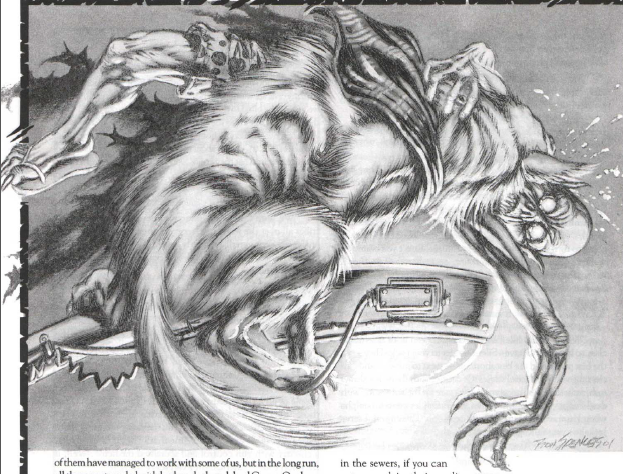
I...I don't even...
 Sorcerers defy Gaia with their magic! However, you can learn some good improvised rituals from them. The Weaver doesn’t like them, which is fine in the Gnawers’ book.
Sorcerers defy Gaia with their magic! However, you can learn some good improvised rituals from them. The Weaver doesn’t like them, which is fine in the Gnawers’ book.
Hunters
: They’re crazy, which means they’re dangerous. If you find one, take them out fast.
 Don’t sleep in a graveyard.
Don’t sleep in a graveyard.
The Fae
: They don’t belong in this world anymore, and it’s killing them slowly. Don’t get involved.
Walks-the-Earth, a Road Warder elder, tells us about the Fera. He’s roamed the world searching for the American Dream (maybe literally), and he’s seen all kinds of weird shapeshifters, like lizardmen. I’m only including the interesting ones, since most of these are pretty generic.
Ajaba
: Some Bone Gnawers from African have hung out with these guys, but the hyenas are crazy and well hidden.
Gurahl
: They’re generous, so long as you don’t let them know you’re a werewolf.
Mokolé
: Sometimes they’re involved in drugrunning. They’re pretty cool when they’re high.
Ratkin
: They’re devoted to chaos. The Bone Gnawers will work with them, but it can get hairy.
The Miseries section is a bit of an anomaly for a tribebook. Essentially, it’s a list of metaplot-tangential plothooks for Bone Gnawer focused chronicles.
The Nosferatu are beginning to stir. As the Bone Gnawers claim more territory, they’re more likely to encounter unsubtle vampire activity. A big conflict between the two groups is almost certain to go down.
The Ratkin are returning from the Umbra en masse, and the shamans devoted to Rat are in a perfect position to figure out what they’re up to. They have some big plans, that’s for sure, and they might cause some massive damage.
There’s a spiritual conflict going on between two aspects of Rat. The Mother Rat is a spirit of generosity, compassion, and charity, while the Rat God is a totem of war. Followers of the two aspects are engaged in debate over the tribe’s approach to the Apocalypse. Whether the Gnawers will help the weak through Armageddon or attack the Wyrm in a death swarm is unclear. Extremists are already beginning to rally followers and stir trouble.
The rabble is growing and it’s becoming more difficult to involve them in the tribe. Integrating them into werewolf society is going to be essential for the final battle. However, many of them plot rebellion, making the Garou Nation into a more egalitarian society. Can the Nation afford such upheaval when the end is nigh?
The Hood plans a revolution against the wealthy, toppling them to help the needy. Bone Gnawer elders oppose them, but their resources are strained already. They might not be able to stop the Hood’s reckless plans.
The Ring of Shadows is a rumored conspiracy of Bone Gnawers, Ratkin, and Nosferatu. What his conspiracy is up to is unclear. Perhaps the Nosferatu secretly run the Gnawers, or they’re planning to blow up a city.
After all this, we need to know how Bone Gnawers have fun. Subway surfing is always a good time. It’s exactly what you imagine: there werewolves jump on the roof of a subway car and ride it. Certain Gifts can prevent a Veil break. It can draw the attention of some unsavory types, though, so it can be dangerous. Still, all Gnawers are encouraged to ride the rails at least once. The Feast of Fools picks one Gnawer to be treated like a king for the day.
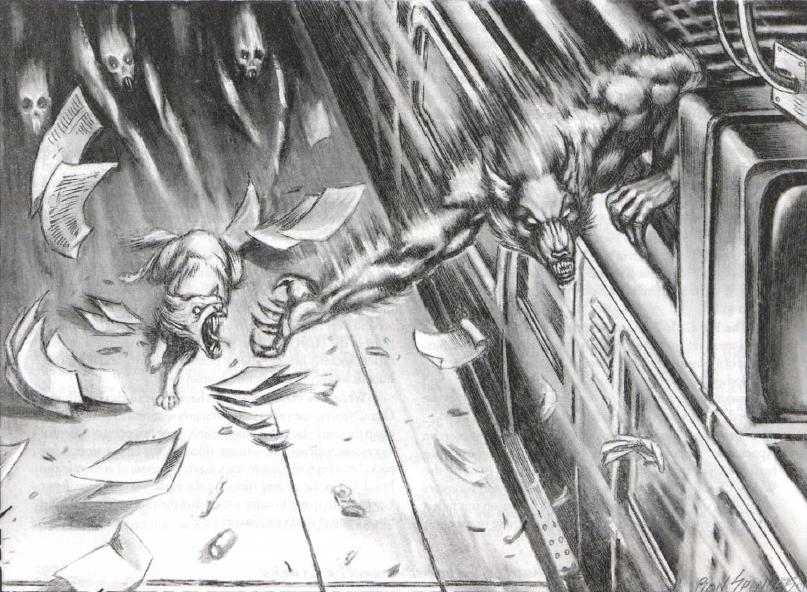
This is more like it.
Next time: Let’s make pipe bombs.
Backgrounds
Original SA post Tribebook: Bone GnawersChapter 3, Part 1
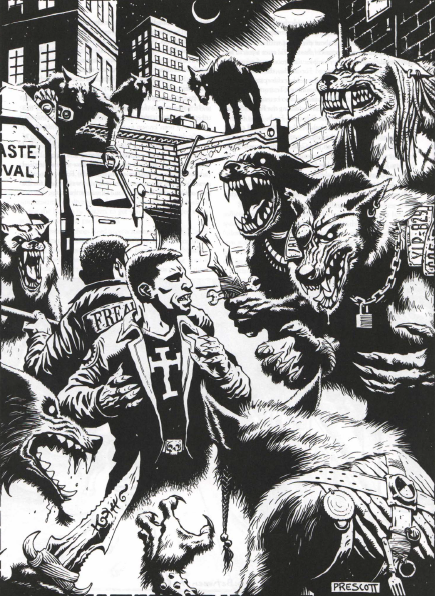
Way to uphold the Veil, guys.
Like all the tribebooks, the book sees fit to advise us on how to pick Backgrounds for our Bone Gnawer character. Unlike other tribebooks, they actually offer non-generic, useful hints.
Bone Gnawer Allies are often influential but charitable figures that can give a Bone Gnawer a hand, in some ways replacing their nonexistent Resources. You might get shelter from an Ally, and it comes with no supernatural or political strings attached. Sounds good, right? Well, when one of the suggested Allies is a kindly old lady who recognizes you from a homeless shelter, it kind of puts the utility of mundane Allies against, say, a Fetish into question.
Bone Gnawers can’t access their Ancestors , so don’t try it! If a player wanted, I would probably be amenable to letting it fly, though. There’s less compelling reasons to deny Bone Gnawers access to Ancestors than Resources or Pure Breed.
Contacts are something of a Bone Gnawer specialty. They keep their ears low to the ground, so they can get all kinds of juicy information from a variety of street level sources.
More so than other tribes, Bone Gnawer Kinfolk can be anybody. They do tend to be poor or at the very most low middle class, though. Kinfolk can be a little more useful than Allies, though, so you can create Kinfolk with a very special set of skills. Dock workers might be useful for physical aid, or you could have some seedy criminal relatives.
The book actually gives good guidelines for creating your own Fetishes . A good rule of thumb is to allow Fetishes to replicate a Gift of a level equal to the Fetish’s dot value. A two dot Fetish could have a level 2 Gift, for instance. This is especially appropriate for the Bone Gnawers, whose Stuff based magical system lends them to have a lot of easy to use Fetishes. Bone Gnawer Fetishes tend to be common, but broken modern day items. They don’t really have a lot of tech uses, per se. Instead, they focus on practical needs. Examples include a Styrofoam container that refills with cheap fast food, milk cartons that can track missing children directly, or a bucket that deals lethal damage if you hit someone over the head with it.
Because Bone Gnawer kin is so scattered, they can’t take Pure Breed . As discussed previously, there’s no such thing as the idealized Bone Gnawer.
Bone Gnawers also can’t take Resources , but dealing with that is a little more nuanced. Resources indicates a reliable income stream, which defies the basic notion of a Bone Gnawer. They can have money to use, but it’s always transitory. Money is spent quickly, and borrowing it can be a risky venture. Sources for borrowing money tend to dry up fast when you can’t pay your debts. There are ways for a Bone Gnawer to come up with money, though! You can make a modified hunting roll to “hunt” for money. Just replace Primal Urge with the appropriate ability. You can only make this roll once a day.
Unlike Merits, the nWoD equivalent to Backgrounds, Backgrounds usually can’t be increased with experience points. You can only get Backgrounds in play via Storyteller fiat. Befriending people gets Allies or Contacts, finding a Fetish gets you Fetish dots, and so on. Bootstrapping is an optional rule to change that. You can buy Backgrounds based on their current rating. This means that adding a new Background where you have no dots can still only happen by Storyteller fiat.
But there’s another optional rule to fix that! You can take a Background dot where you didn’t have one before for that chapter, but you get half the experience for that chapter. You can’t keep it though unless you really earn it.
Since all of this is contingent on the Storyteller using these optional rules anyway, you could just ask him for the opportunity to earn Backgrounds, but most roleplaying game rules preclude actual adult communication. These rules are silly, but if a Storyteller is a grognard who really can’t handle players getting stats for “free”, then he might like these better.
Without any introduction, here are the Bone Gnawer Gifts! Like last time, we’ll look at both the Revised core Bone Gnawer charms and the tribebook’s additions. While it may have seemed weird for the Black Furies, there’s a very good reason to do this with the Bone Gnawers.
First, the core. The trademark Bone Gnawer Gift is Cooking , a Level 1 Gift that allows the Gnawer to cook anything and make it edible. It doesn’t necessarily taste good , but it can be eaten. Resist Toxin is found in several tribes’ Gift list, but the Gnawers learn it from a trash spirit. Tagalong is a weird one. It allows a Gnawer to receive the benefits of a pack totem without actually joining the pack. The pack does have to consent to the Gnawer tagging along, though. From the 20th Anniversary Edition, there's Scent of Sweet Honey , which sounds lame until you realize it allows a Gnawer to sic a bunch of fleas and rats on a person for a day, penalizing every action they take. It also includes Trash is Treasure , which allows a broken or worn item to function as if it was in perfect condition. This incidentally allows you to fire an unloaded gun.
Similar to Cooking, The Hungry Hound allows the Gnawer to find the nearest source of edible food. Ironically, it’s taught by a raccoon spirit. Cooking is generally better than this Gift in every way, though, since it allows the werewolf to eat anything everywhere, without a hunt required. Smell of Success is much better, enabling a Gnawer to smell how wealthy a passerby is. Urban Ward sets up an alarm around a certain area. As you can imagine, the LARP rules for this are ridiculously complicated. Similarly, The Mark allows you to mark your territory in the traditional canine manner. A dog spirit teaches this gift, of course.
Declamation allows a werewolf to read things really quickly and remember all of it. It’s used by the Frankweilers and Ratfinks. This is where the problems with the Gifts in this book start becoming apparent. While most of the Gifts here are mechanically sound, there’s some conceptual drift going on. There are so many Gifts in this book, but so few that you can actually imagine a Bone Gnawer actually taking. Look at Desperate Strength . It allows you to take aggravated damage to improve a Feat of Strength roll, but what about that suggests “homeless werewolf”? It would be much more appropriate in Get of Fenris or Silver Fangs. W20 handles this better by downgrading the damage to bashing and decreasing the bonus accordingly. It's less allowing you to do ridiculous stunts via self harm and more draining your energy to perform certain tasks.
 Kitchen Chemistry
Kitchen Chemistry
 . Hoo boy, Kitchen Chemistry. With ten minutes, one point of RAGE, and any three common kitchen chemicals, you can make a bomb. How much damage does it do? One level of aggravated damage for each dot of permanent RAGE the Gift user has. This means that an Ahroun that doesn’t buy up his RAGE can get a Gift that does five levels of aggravated damage at chargen. Since aggravated damage is unsoakable and unregenerable, this is enough to kill some supernaturals in a single explosion. The only complicating factor is that it requires an Intelligence+Science roll to use reliably, but it’s difficult 6, meaning that on average you’ll get half your dice pool in successes. Basically, any Homid or Metis that takes this can render any combat irrelevant. “Imbalance” is a term that’s thrown around a lot, but this right here illustrates all the problems imbalance causes. If you have decent RAGE, Intelligence and or Science stats, why would you take any other Gift? I mean, if you were a Bone Gnawer IRL, Cooking would be really cool, but most Storytellers aren’t going to really call for hunger checks. No one’s going to look at a flavorful thing like Cooking when Kitchen Chemistry exists. Again, the LARP rules on his are complex and onerous.
. Hoo boy, Kitchen Chemistry. With ten minutes, one point of RAGE, and any three common kitchen chemicals, you can make a bomb. How much damage does it do? One level of aggravated damage for each dot of permanent RAGE the Gift user has. This means that an Ahroun that doesn’t buy up his RAGE can get a Gift that does five levels of aggravated damage at chargen. Since aggravated damage is unsoakable and unregenerable, this is enough to kill some supernaturals in a single explosion. The only complicating factor is that it requires an Intelligence+Science roll to use reliably, but it’s difficult 6, meaning that on average you’ll get half your dice pool in successes. Basically, any Homid or Metis that takes this can render any combat irrelevant. “Imbalance” is a term that’s thrown around a lot, but this right here illustrates all the problems imbalance causes. If you have decent RAGE, Intelligence and or Science stats, why would you take any other Gift? I mean, if you were a Bone Gnawer IRL, Cooking would be really cool, but most Storytellers aren’t going to really call for hunger checks. No one’s going to look at a flavorful thing like Cooking when Kitchen Chemistry exists. Again, the LARP rules on his are complex and onerous.
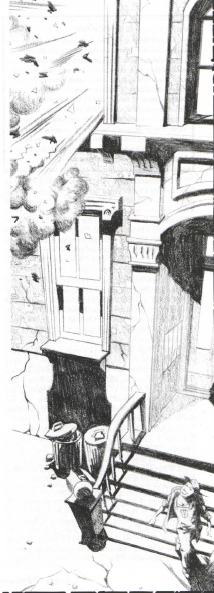
Rat'll just teach anyone how to blow up entire rooms of people.
Next time: Holy shit, there are a lot of Gifts.
Gifts
Original SA post Tribebook: Bone GnawersChapter 3, Part 2
The Bone Gnawer tribebook organizes its Gifts a bit differently than its counterparts. As we saw in Black Furies, most tribebooks have Gifts that only members of a particular camp could take. Sometimes this didn’t make a whole lot of sense, since some camps like the Amazons of Diana didn’t really formally initiate members, but it also did a good job of actually distinguishing one camp from another beyond the weak fluff writing. Here, though, the camps are described well enough to actually be compelling in their own right, so every Gift here can be taken by any Bone Gnawer.
On to Level 2 gifts, then. In the core, Bone Gnawers can pick up Blissful Ignorance from the Ragabash Gift list, allowing any Bone Gnawer to temporarily erase a memory to avoid giving away secrets. They also get Odious Aroma , which increases a Gnawer’s stank to the point that anyone in the vicinity gets a -2 penalty to all actions from choking. W20 has Cornered Rat’s Ferocity , which sends the werewolf into a frenzy, boosting all attack rolls. Between the Cracks points out a secluded urban area to perform rites or to set up a Stomping Ground. Guise of the Hound allows a werewolf to shapeshift into a dog, rather than a wolf, to better blend into an urban environment.
From the tribebook, Dead End allows the Bone Gnawer to create a misleading graffiti tag or redirect a street sign to prevent someone from tracking him. Basically, you become Bugs Bunny. It increases the difficulty of finding the Gnawer “beyond that point”, but I really have no idea what this means. Road Ward is better, allowing a Gnawer to jump off a car or other vehicle going 75 mph or more without taking any damage. A wanderlust spirit teaches the Gift. On Patrol is an enhancement to Sense Wyrm or other Gifts that can detect supernatural creatures, increases the Gift’s radius to an entire city block.
Stone Throwing Devil increases throwing damage. It’s useful for rioters. I Got a Rock also boosts your throwing capability. It says that it increases throwing accuracy, but really it lowers the difficulty of throwing anything, no matter how cumbersome, to 4, which is insane. You just need to be able to lift the item in question.
Hootenany is a standout Gift. Used by the Hillfolk, it’s basically Inspire Competence for werewolves. A werewolf plays a musical instrument, and every member of his pack gets dice to increase their Athletics or Brawl checks. Any enemies in the vicinity have to succeed a Willpower check or they’ll be forced to dance. The book recommends performing Dueling Banjos.
Core Level 3 Gifts include Friend in Need , which allows a Gnawer to lend willpower, RAGE, Gnosis, Gifts, or even health levels to a packmate or fellow Bone Gnawer. They also get Reshape Object from the homid Gift list. Instead of Friend in Need, W20 includes Call the Rust , rendering a metal device unusable, taught by a water spirit. Gift of the Termite does the same thing, but with wood. Gift of the Skunk is, of course, taught by a skunk spirit. It gives a werewolf musk spray, which can incapacitate targets. It doesn’t work on beings with no sense of smell, though.
The tribebook brings us Lucky Bastard , a once-per-session reroll. Streets Tell Stories gives a Gnawer limited postcognition on any city street. It’s taught by a City Father or Mother itself. Laugh of the Hyena boosts a Gnawer’s resistance to mind control, as long as he laughs out loud. Rant and Rave allows a Gnawer to speak crazy talk that can only be understood by packmates. The werewolf can also send psychic messages across a certain distance, across the state at its highest level. Yes, this does mean that it has less range in Rhode Island than Texas.
Cooter’s Revenge enchants a car repair tool, decreasing the difficulty of all repairs with that tool to 4. RAGE allows it to be used as a weapon. This isn’t the last Dukes of Hazzard reference in the book, either. Dumpster Diving allows a werewolf to teleport from one dumpster to another anywhere in the planet, at the Great Trash Heap’s discretion. After all, all trash piles are just fallen reflections of the Great Trash Heap’s might.
At Level 4, Bone Gnawers can learn Attunemnt from the core, allowing the Gnawer to ask city spirits anything. Infest summons vermin to wreck a house. W20 has Blink , a more quick and reliable urban teleport.
The tribebook offers Shadow of the Rat which is a straight difficulty buff to all Stamina rolls. Pretty boring. Face in the Crowd allows a Gnawer to direct an already extant angry mob. Trust Me makes one lie a Gnawer tells in a session completely believable, no roll required, as long as he ends the story with “Trust me.”
Level 5 core Gifts include Riot and Survivor . Riot creates just that, a riot. Five successes on a difficulty 8 Wits+Subterfuge roll can send an entire city into a riot. Survivor removes the need for sleep, drink, or food for a certain amount of days. An extra Gnosis point can add Stamina levels and remove wound penalties, but the duration is cut short.
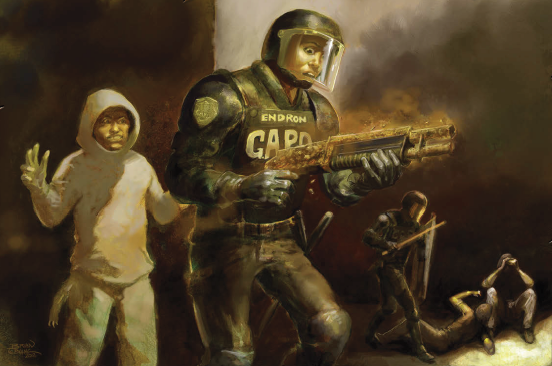
From W20, featuring the cut Gift: Hug of the Raccoon
From the tribebook, Piping sends out a summons to all the Bone Gnawers in a city. Help Me makes a human so compassionate towards a Gnawer that he’ll go to ridiculous extremes to help the werewolf out. He might empty an ATM account, or lend the Gnawer is car. Abuse can carry Honor penalties, though.
Next time: Rite of the Pizza
Rites
Original SA post Tribebook: Bone GnawersChapter 3, Part 3
All tribes put their own spin on Rites, but Bone Gnawer Rites are the spinniest. While other tribes rely on repetition of proven methods, Gnawer Theurges throw whatever works together. Other tribes may consider this blasphemous, but it’s really hard to find the necessary components for an ancient nature rite in a contemporary city. Optionally, an ST may make the Rite more difficult with improvised ingredients, in return for extra renown awards from Bone Gnawer elders. Gnawers can even make up their own rites! There aren’t any rules for this, though, but many current Gnawer rites are based off of those improvisations or variants on pre-existing rites.
Rite of the Cardboard Palace creates an adequate shelter for a Bone Gnawer out of cardboard and assorted trash. It’s bigger on the inside, and it won’t break the Veil. It’s such a great palace, you can heal aggravated damage inside. The Rite of the Pizza requires calling up a gang of Gnawers and agreeing on buying a pizza, unanimously agreeing on toppings. Should this requirement be resolved, the group can decide on a specific goal and receive extra dice they can spend on tasks directly related to that task. The difficulty on the roll to get these dice is really high, though, so you’re most likely only going to get two. The LARP rules literally require buying an actual pizza and sharing it.
Rite of the Crash Space is an upgrade to the Cardboard Palace; it makes recovering Gnosis in your hovel easier. Rite of the Shopping Cart makes any container into a limited Bag of Holding.
Rite of the Cardboard Fortress , as you can probably guess, is another upgrade to Cardboard Palace. It’s even bigger and you can use it as a gate to the Umbra. If the fuzz smashes up your fortress, they’ll find nothing inside. Rite of Man Taint is a contested roll to find out whether a werewolf ate a human. Rite of the Leash is a very severe punishment rite that attaches a leash to a Gnawer for breaking a law, humiliating him. He can’t run away, for the leash is unbreakable.
Rite of the Signpost makes a particular road really inhospitable to travel. It’s creepy, easy to get lost in, and really smelly. Getting through the route requires a Willpower roll. Rite of No Trespassing does the same thing, but allows many werewolves to cooperate, making the Willpower roll more difficult.
Time for Fetishes, then! Lost Keyring is a keyring full of assorted keys. Making a Perception+Repair roll based on the complexity of any given lock allows you to find the key for that lock on you keyring, allowing you to open any conventional lock. If it’s a key card system, you’re out of luck. Ivan’s Molotov is a magical Molotov Cocktail that causes a ton of aggravated damage. It’s basically the Fetish version of Kitchen Chemistry. The Whole Gym Bag is a Bag of Holding that transforms with the werewolf, but it can’t hold technological items, meaning guns and computers.
Rover’s Whistle is a dog whistle that works on werewolves. It can also summon a ton of stray dogs. Hitching Glove compels a driver to pick you up when hitchhiking. Spirit Radio is a little bit more inspired. It allows you to eavesdrop on spirits, getting news reports on spiritual activity all over the city. Umbral CB allows a werewolf to broadcast into the material realm from anywhere in the Umbra. Trucker lingo is required, though.
Merits & Flaws: Struggling gives a Bone Gnawer access to Resources, as he has a minimum wage job. On one hand, this can derail an entire chronicle, since the PC has to accommodate working in addition to werewolf adventures, but on the other hand it’s a good explanation for why a character’s absent when his player’s missing a session.
Shame is actually a Merit, as it gives A Bone Gnawer access to Ancestors, albeit from another tribe. See, the character is actually descended from a disgraced member of another tribe. This gives your character a dark secret though, as if other Garou learn about your ancestry, your social rolls with them are penalized, especially if they’re from your ancestral tribe. It’s a very effective plot hook, basically.
Ratkin Buddies is a more expensive Merit, but Ratkin can be pretty useful allies. Once in a story, the ST rolls on a table. On a bad day, Ratkin mess with you. On a good day, Ratkin will help you out, or even give you a present. 40% of the time, they’ll do nothing. Ratkin won’t reveal themselves to members of other tribes, though, so that can be a good plot hook. That doesn’t really justify taking this merit over Allies, though, if you want Ratkin friends.
Anosmia means you can’t smell! This penalizes hunting and Lupine Perception rolls, of course. Lost Homid means you’re a feral amnesiac, with the same Ability restrictions as a Lupus! It’s only a 2 point flaw, even though this is character defining and a ridiculous challenge to overcome. Phobia is obvious, but why it’s in the Bone Gnawer book is less so. Jackal’s Blood is the only Flaw here with teeth. It basically gives the ST a chance to completely screw you over once a session, in any way he sees fit.
On to Totems, one of the most fondly remembered sections of the book, and deservedly so. Totems have always been one of my favorite parts of Werewolf, since they're a very clear statement of purpose on the part of a PC group, a fun character, and a source of a lot of great symbolism. This book gets that very well. First, we get an explanation of totemic aspects. A totem can symbolize different things to different tribes, thus granting different abilities. The moon itself is a great example of this: it’s alternately a warrior, bard, lawyer, mystic, or trickster, depending on its phase. Rat has three major aspects: a trickster/stealthy form, a war god form, and a nurturing form. Most Gnawers see Rat as the tricky clever warrior, but two extreme camps have rallied around the Rat God and the Mother Rat.
Followers of the Rat God are obsessed with violence for violence’s sake. They can’t be tricked into serving anyone else, not even with Mind magic or Dominate. They only serve their God. Devotees of the Mother Rat are compelled to offer charity to anyone who demands it, particularly children and Metis. Any aspect of Rat can take on the form of any given rodent, leading the Bone Gnawers to treat them with reverence. This makes Owl’s command to sacrifice rats especially scandalous to the Gnawers.
The American Dream is lost, but certainly not dead. Its followers are compelled by optimism about the future of the nation and of themselves. They know that America is filled with good people and they seek to help those people out. The American Dream doesn’t offer much advice, but it comes at exactly the right moment, usually in the guise of an average American citizen. Because recognizing the Dream in its incarnate form is so difficult, its followers treat everyone with respect. To those with a more mystic, Wyld bent, the American Dream can appear in the form of a Norman Rockwell painting come to life. STs are advised to designate one minor mortal character in a chronicle as the American Dream in disguise, who will come to the pack’s aid when they really need it.
Followers of the American Dream get a couple of benefits. They can’t get lost in the USA, even when compelled. They also get 2 dice in Athletics and Empathy to share. The Athletics bonus doesn’t apply to hockey or soccer, and Empathy doesn’t apply to foreigners. Everyone in the pack gets Social bonuses when dealing with officers of the Constitution. Followers are also compelled to act obnoxiously when dealing with foreigners or overseas.
Tasmanian Devil, the old Bunyip totem, has chosen to patronize the Bone Gnawers. He grants everyone Hare’s Leap, 2 extra points in Enigmas, and easier access to the Umbra. Her followers have to advocate for the Bunyip and pass up no opportunity to kill Black Spiral Dancers, who tricked the Garou Nation into killing the Bunyip.
The General Lee isn’t the Civil War general, but is the totem of Cars, taking on the aspect of the greatest car of all time. A pack devoted to the General must choose a rundown car to repair. This car houses the General. As they increase in rank, the car’s capabilities increase with it. At Rank 5, the car can drive into the Umbra. At any level, the car is the Coolest Car. The difficulty of stunts or chases is decreased and every member of the pack gets points in Drive and Crafts (specialty automotive repair). They can even reroll failed Drive checks at Rank 3. In return, they have to spend an hour a day maintaining their vehicle.
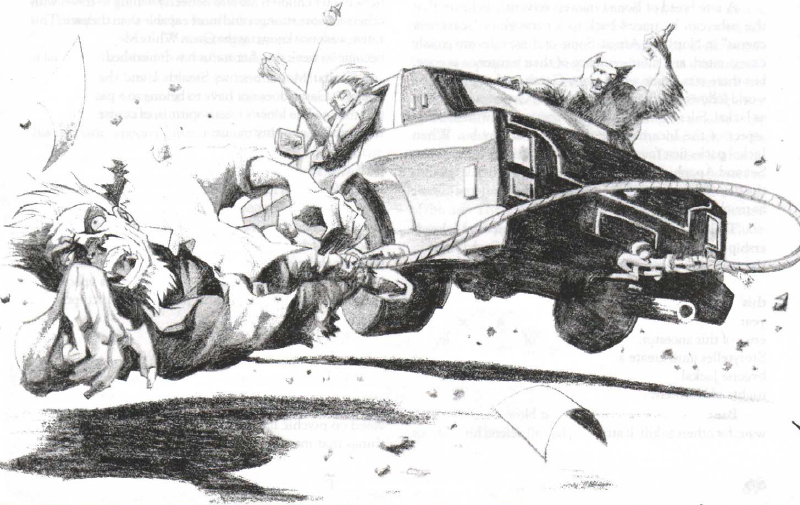
Boss Hogg has opposed the Duke boys for the last time.
Jackal was an ancient patron totem to the Bone Gnawers when they hailed from Northern Africa and he still offers his aid. His followers get Survival 2, Leadership 1, and Blur of the Milky Eye to share. He also grants 1 dot of Ancestors to each of his followers, even if they’re Bone Gnawers or Silent Striders. Glass Walkers miss out. Devotees are loath to strike first in a fight, as befits a scavenger. If they do attack first, the Storyteller can turn one failed roll into a botch within three sessions.
Mouse is a bit of a curiosity. She only costs one background point, but he only grants one point of Stealth and Tagalong. She basically exists to introduce followers to other, more powerful totems to follow. She forbids her followers from breaking the Veil for any reason.
The Great Trash Heap is the totem of junk. His consciousness is spread through every individual trash pile, dumpster, and land fill in the world. Once a moon, he’ll answer any question from his packs. Members of a GTH pack can contact each other through tin cans and get Enigmas and Investigate 2. They must live on a trash heap, though.
Crow is another scavenger spirit, but the aspect the Gnawers respect is one of loyalty. His followers must fanatically rally behind a cause or party, and in return they receive points in Alertness, Subterfuge, or Etiquette. He’s usually on hand for advice as well. His devotees can also choose to take a vow of poverty, and in return they get extra renown and a murder of crows they can use for any purpose, which is amazing considering Bone Gnawers can’t have Resources anyway.
Hyena is a constant critic of authority and a savage fighter besides. His trademark is manic, derisive laughter. His followers get extra willpower, Primal Urge, and Subterfuge, as well as Laugh of the Hyena when they reach Rank 2. However, his followers also tend to go crazy, requiring a daily willpower roll to resist madness.
Next time: Mediation via chain beatdown
Sample Characters
Original SA post
This tribebook takes a different tack for their sample characters, not recommending them as PCs at all. Even the historical figures are meant to have their stat blocks repurposed for personal characters. Common sense to someone not used to metaplot, but good advice nonetheless.
Rabble Rouser
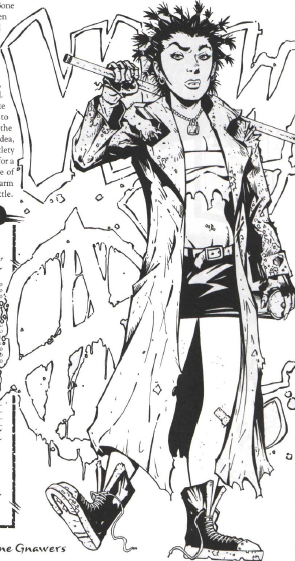
How nineties, for a book published in 2002.
quote:
The Time is almost at hand. Spread the word.
The Rabble Rouser came from a hard scrabble background. Her dad was always away on “business” with his “pack” of “buddies” and her mom was poor. Turns out, she was a Bone Gnawer. Her dad sacrificed his time with his family to serve the sept, but both he and his daughter were treated like scum. The other Bone Gnawers, though, helped out the Rabble Rouser. So, RR has decided it’s time for revolution. You still have to keep it on the DL, though, since you don’t actually have the backing of the rabble just yet. Basically you’re a spy.
Gotta say, not a great character archetype. Ragabash are supposed to be all about “questioning the ways” anyway. This is a pretty personal crusade, too, unless you’re building the chronicle around revolution. If you need a quick young Turk werewolf, though, you can look to the Rabble Rouser, I guess. She’ll be crap in a fight with tertiary physical traits and only two dots of Brawl, but if you’re not playing her that’s fine. Her Gifts are well chosen, Persuasion for social stuff, Blur of the Milky Eye for sneaking, and Tagalong to better support her role ingratiating herself to diverse communities For some reason, she has a lot of Rites and Rituals dots, which I suppose means she’s supposed to be a revolutionary leader, but otherwise she’s statted out like a starting character. Her equipment includes “anarchistic literature”
 A poor showing.
A poor showing.
Bird Lady
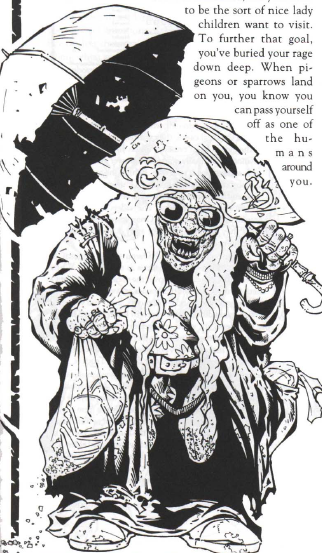
Pictured, someone passing herself as a "kind old lady"
quote:
Here, pretty, pretty, pretties! Come and tell me what you’ve been doing in this big, dirty city! Yes, come and tell me!
A lot of oWoD splatbooks have a habit of making their sample characters X profession, but a supernatural creature! This is a good example of this. A crazy bird-feeder, but a werewolf! She’s forgotten what it’s like to be human, if she ever was a human (her breed is Lupus, so no). All she remembers is playing with birds, and the birds being there after her change. Feeding the birds helps her keep her cover up, which is good because she can’t stand being around anybody other than birds.
Again, playing as this character would suck, but for entirely different reasons. While playing a werewolf revolutionary could be pretty cool, this character is a fishmalk, plain and simple. The roleplaying hints give her free reign to babble incoherently around other people. Her statblock is useful if you want a mad street prophet Theurge, but again, she’s built as a starting character. She’s well put together as a mystic, but she’d be even worse off in a fight than the Rabble Rouser, with only one dot of Strength and one dot of Brawl. Don’t play as this character, is what I’m saying.
Metis Mediator
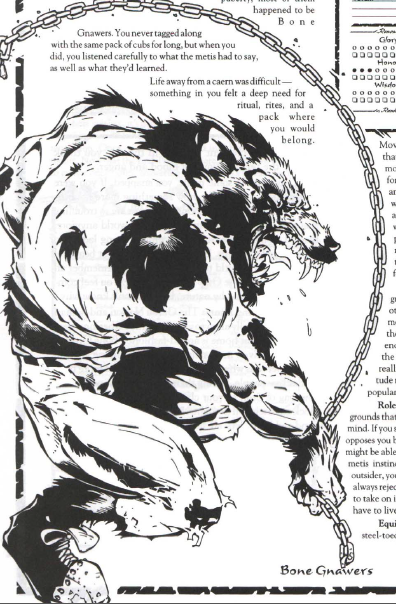
Is it just me, or does this picture evoke the hammer and sickle?
quote:
I thank the sept leader-rhya for allowing me this chance to speak. I ask this opportunity not merely for my own sake – but for the sakes of all those whose voices were never heard.
 In the lesser tribebooks, being a Metis is used as a character hook all on its own. While the Metis are compelling, relying on that hook is going to be boring. This character is built along those lines. He was raised by a sept of another tribe, who taught him that to make up for his sinful existence, he needed to die for the sept. When he realized that this was wrong, he left and was accepted into the Bone Gnawers. Even in the Bone Gnawers, leaders just wanted him to serve their schemes. Once the Mediator stood up for himself, he earned the respect of the Bone Gnawer metis community. Now, he represents them in the Gnawer political arena.
In the lesser tribebooks, being a Metis is used as a character hook all on its own. While the Metis are compelling, relying on that hook is going to be boring. This character is built along those lines. He was raised by a sept of another tribe, who taught him that to make up for his sinful existence, he needed to die for the sept. When he realized that this was wrong, he left and was accepted into the Bone Gnawers. Even in the Bone Gnawers, leaders just wanted him to serve their schemes. Once the Mediator stood up for himself, he earned the respect of the Bone Gnawer metis community. Now, he represents them in the Gnawer political arena.
Now this guy’s built great. He’s got points everywhere he needs them, in Law, Politics, and Etiquette. As a hulk, he’s also got a combat role, and he has points in physical traits, Brawl and Melee. While a werewolf social justice warrior doesn’t get me excited, it might work for someone else, especially if you’re doing a political chronicle. The character’s got an arc to his own. I approve. The only weakpoint is that his equipment includes a copy of Plato’s Republic, which is not only pretentious, but also dumb considering Plato advocated for segregation and a rigid caste system.
Frankweiler Bootlicker
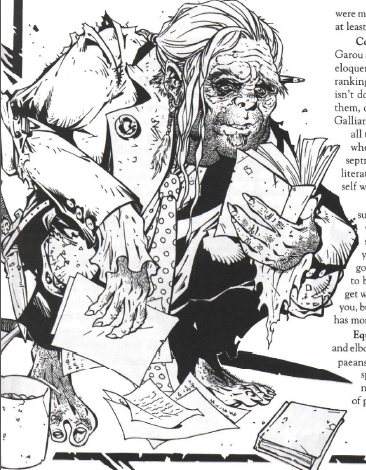
I thought wereapes wouldn't come until Changing Breeds!
quote:
Oh wise and revered elders, if I might be so bold, I have composed a certain ode to the exploits of our most puissant warder, and would love nothing better than honoring him with my humble verse. <clearing throat> “Behold! The thews of the mighty wolf! Far stronger than the forge’s steel
One of two camp representatives. At his core, this character is a bad poet and hero worshipper. Pretty basic, but can make for some really fun roleplaying. Statwise he’s... weird. Physical tertiary, again, but he has a high Intelligence score, which I feel would deteriorate from the fun of playing this character. He’s got a great Dodge score, but no combat skills whatsoever, which is definitely bad for a werewolf character. His Gifts are all over the place, with Persuasion, Cooking, and Call of the Wyld (a magical summons). I’m just baffled by this character, unfortunately earning him the Worst Sample Character badge, since I have no idea what to do with him.
Mountain Man
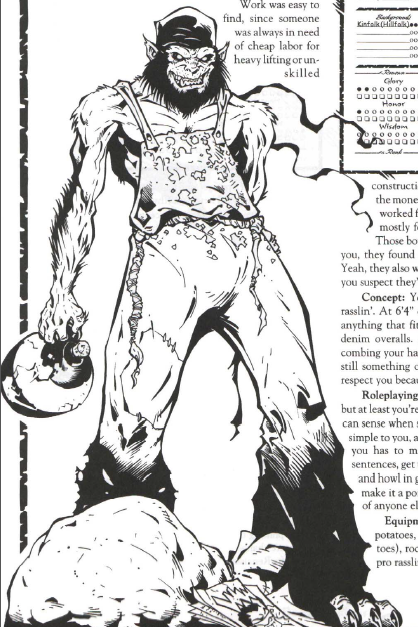
Do hillbillies even use those bottles anymore?
quote:
Shee-it, sure don’t grow them Spirals that big out here, do they? Why don’t y’uns sit back a spell; I’ll handle this lil’ fella.
The other camp representative, and by far the better one. A literal country wolf in the big city, he’s built for one thing and one thing only: killing shit. He’s got the stats for it, too. He’s maxed out Strength, but hasn’t dumped Dex either. He’s dumped Intelligence, which is great conceptually. All of his backgrounds have bone into Kinfolk, and although this is against the rules, it’s great. His Gifts are a little weaker, with Hare’s Leap and Falling Touch standing out as a little weird. Resist Toxin is great, though. This one gets the badge for Best Sample character.
Corazon Bitefinder always had a curious connection to the sea. At birth, his mother tried to drown him, but he survived. He had the ability to sing the fish out of the water. His mother believed he was the spawn of an incubus that had seduced her (hooray, implied rape! I thought we had left you behind in Black Furies). Tired of her constant attempts to kill him, Bitefinder left to seek his fortune. He survived five shipwrecks before his First Change.
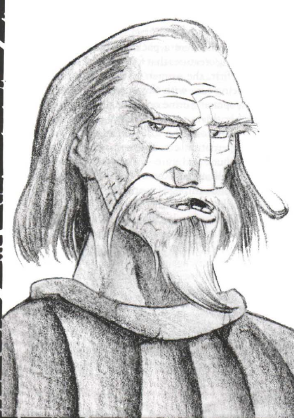
The Bone Gnawers of Lisbon put him to work getting fish for the poor, but Bitefinder just wanted adventure on the high seas. In 1540, the Bone Gnawers held a Piping to discuss exploring the New World. Bitefinder and a few courageous Gnawers offered to lead an expedition, but every voyage Bitefinder was on met shipwreck, so he was mocked. His team stowed away on a ship, and fought a giant Umbral Wyrm monster. They made it to the Americas, and Bitefinder led the remaining Bone Gnawers to the New World.
Henri Eau-de-Fleur earned his deed name through his trademark odor. His Metis deformity was a vicious stank, and his elders taught him Odor of the Skunk and Scent of Sweet Honey before he could handle them as a cruel joke. He was cast down into the sewers of Paris for “surveillance”, but Henri excelled there. He quickly befriended the Parisian Ratkin and learned about all the supernatural happenings in the city.
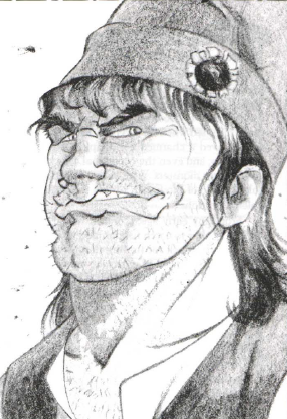
Of particular note was the conflict between the Nosferatu of the sewers and the other vampires of Paris. Henri, other Bone Gnawers, and the Ratkin waged war against the Nosferatu. The Nosferatu tried to claim refuge with the other vampires, but they were turned aside. They then accepted an alliance with Henri’s army and drove out all the vampires of Paris. The Nosferatu were diminished enough to be wiped out in the conflict. Soon after the vampires withdrew their support, the aristocracy fell in the French Revolution. Thus, Henri Eau-de-Fleur is seen as its secrete patron.
Young Blackie Chuzzlewit is a literal legend among the Bone Gnawers. His father, an American railroad magnate, abandoned his mother and left them in destitution. His mother soon died and Blackie was sent to an orphanage, but he left at age six to live on the streets. He moved to a new coal mining town, where he worked as a child miner. When he was trapped in a cave-in, he took his First Change and stepped sideways. Eventually, he found his way to the Scar, and there is where his adventures began. Basically, if Charles Dickens wrote epic fantasy, he would write of Blackie Chuzzlewit.
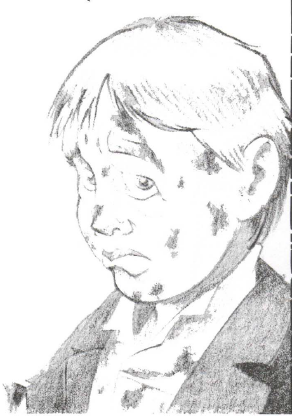
Conquerer of the Scar, ladies and gentlemen.
Mother Larissa is the Mother of the Sept of the Green in New York City. Despite heavy opposition, she’s held leadership for decades. Her sept will shelter anyone who needs it. She presents a front as a crazy witch, and offers consultations. She loves telling cheesy ghost stories, taking inspiration from House of the Dying , a seventies comicbook and a riff on Tales of the Crypt . She’s getting old though, and she’s curiously reluctant to leave her personal haven on an island in Central Park. The Bone Gnawers of New York hope she’ll rule for a couple more decades, though. She probably won’t be much good in a fight, but she’s got the mental and social stats to be a powerful ally.
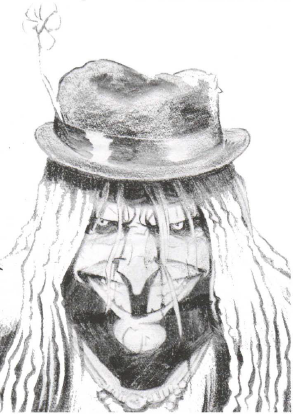
Really, lovely when you get to know her.
Carlita Gutierrez, aka “Big Sis”, is the signature Bone Gnawer! She changed as an eight year old Cuban squatter in Tampa. She’s fifteen in 2002 and she’s already Rank 2. She’s committed to helping her new Bone Gnawer family after tragically killing her family when she hulked out. She’s an able pugilist, and as a Philodox she has a keen sense of justice. Eventually, she wants to become a Mother, but rather than offering material generosity, she makes her name by kicking ass. She’s beaten fearsome banes and Black Spiral Dancers, and even helped Jonas Albrecht’s pack kill the legendary beast Jo’cllath’mattric. Currently, she serves as an emissary between the major septs of Florida. In my opinion, Werewolf as really cool signature characters, and Carlita’s one of the best.
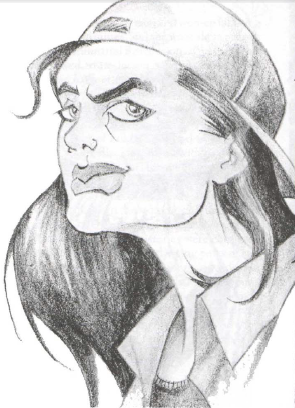
And on that happy note, the tribebook is over! What did I think? It’s really good! But you all knew that. The Bone Gnawers aren’t my favorite tribe, but this book really warmed me up to them. It’s very focused on their theme, that they’re at the bottom of the totem pole when they feel that they do the most good. They have no hope of ever bettering themselves, so they revel in their status as losers. All they can do is keep on trying to protect their charges as best they can.
The book’s full of great ideas and setting materials. This book alone can be used as a guide to running urban Werewolf stories, it’s that good. There are a lot of mechanical problems, but those can be overlooked because of all the fantastic fluff. I’m not really any more likely to play a Bone Gnawer in the future, but it looks like a lot of you are, which means it’s done its job.
Next time: Let’s take a palate cleanser with Bunyip, then move on to First Edition Children of Gaia, shall we?